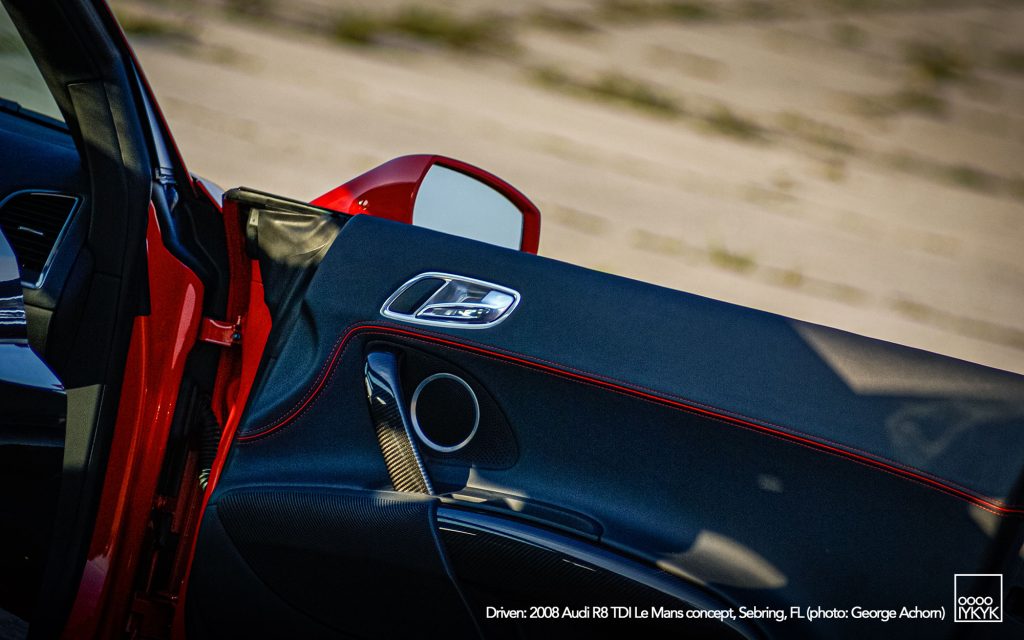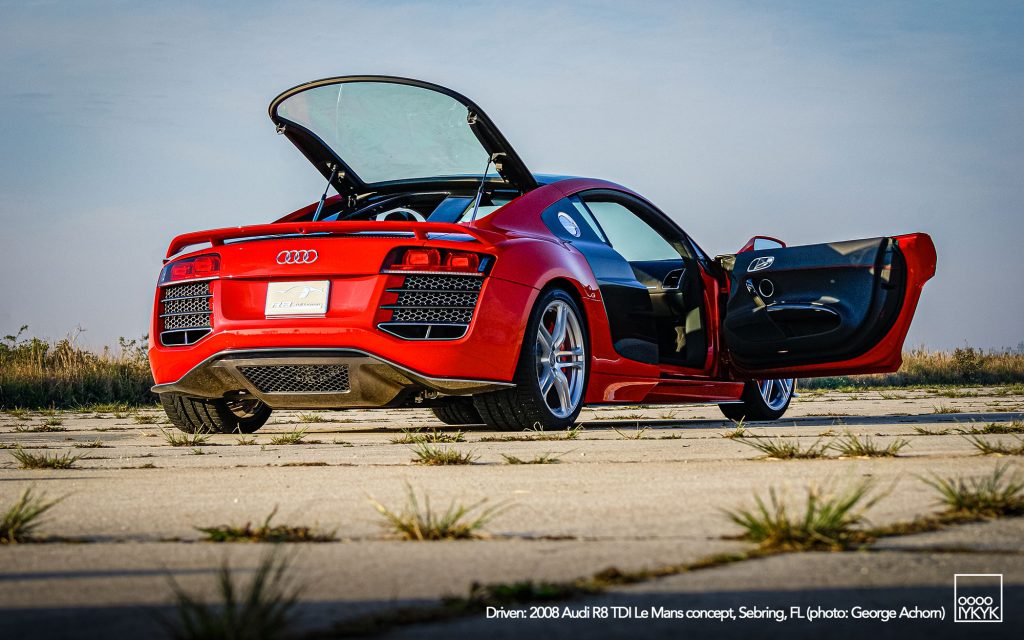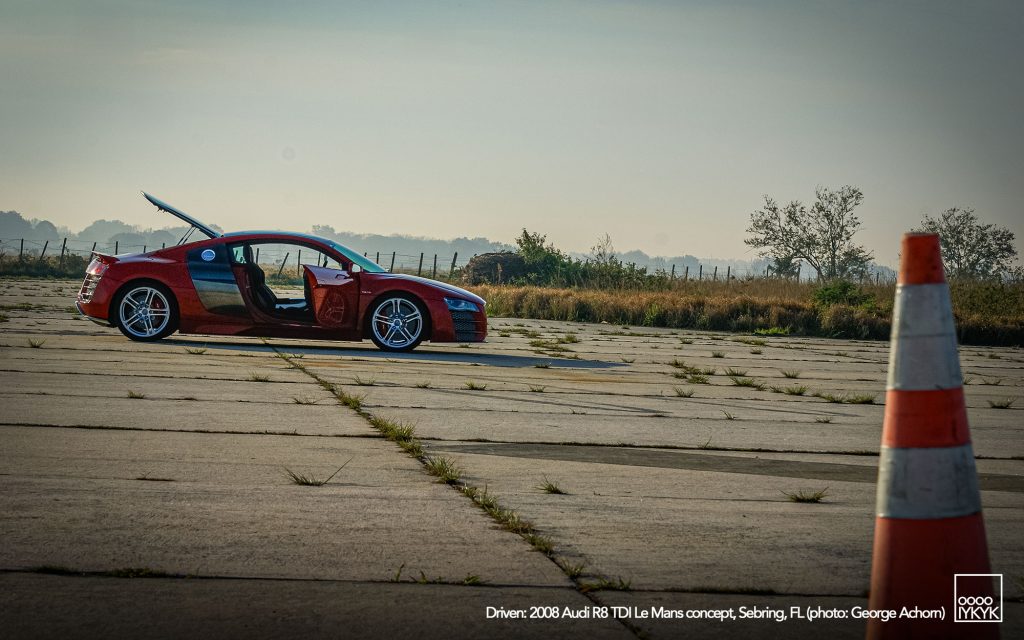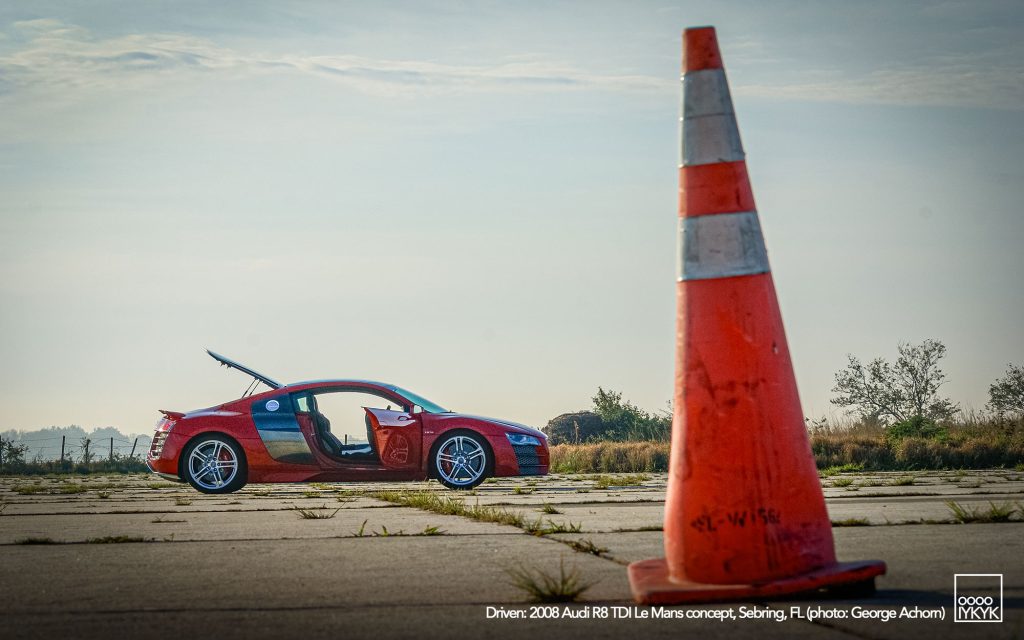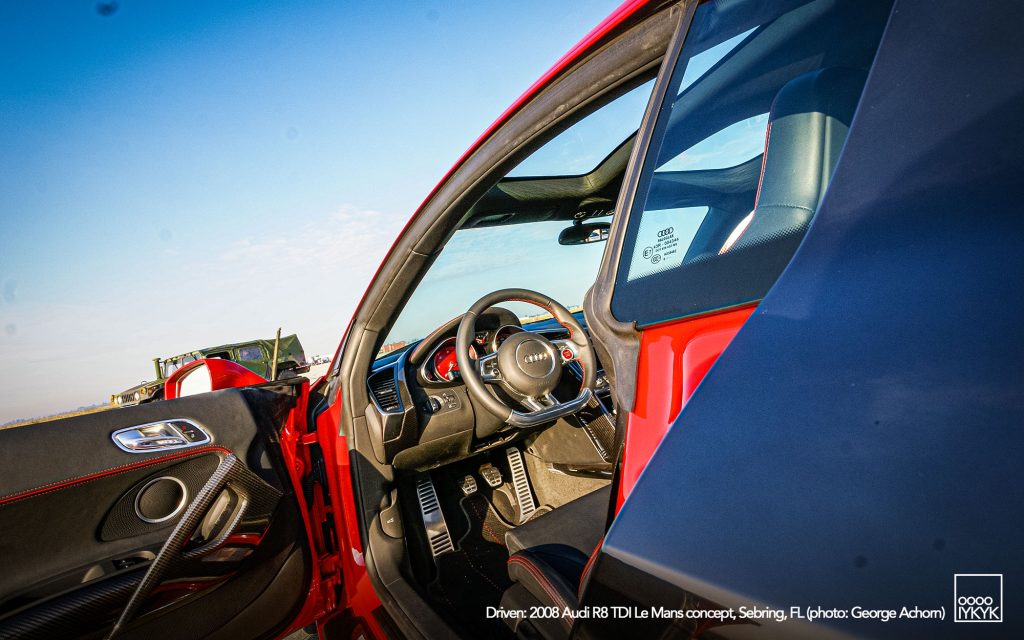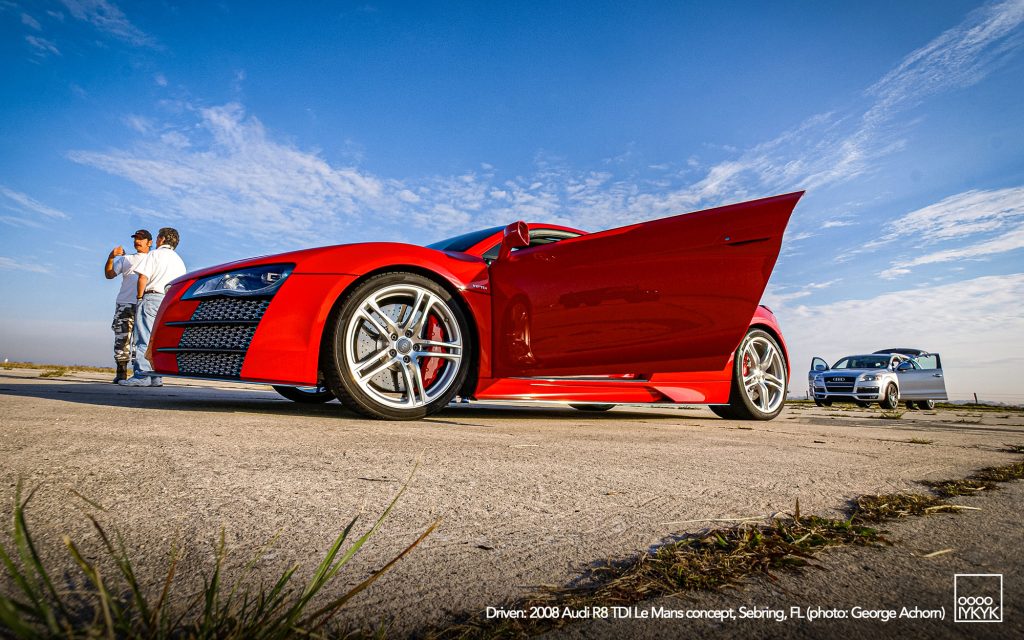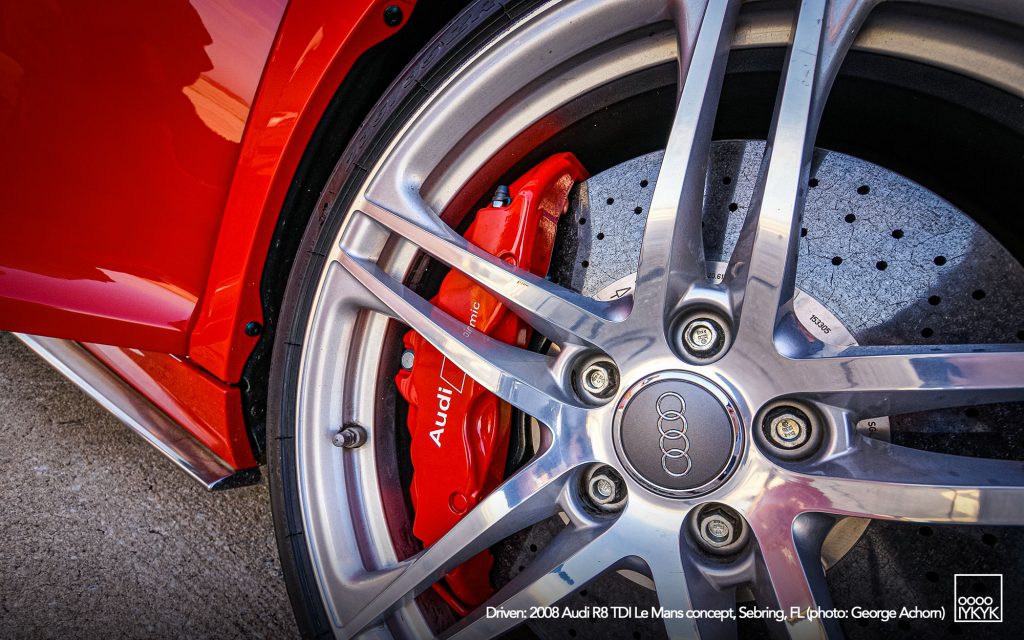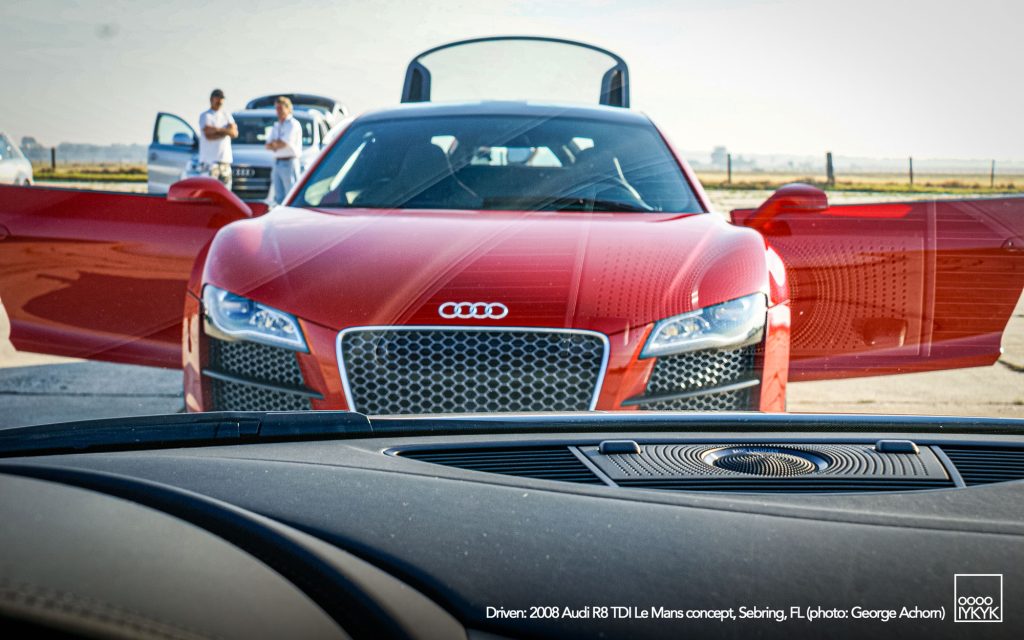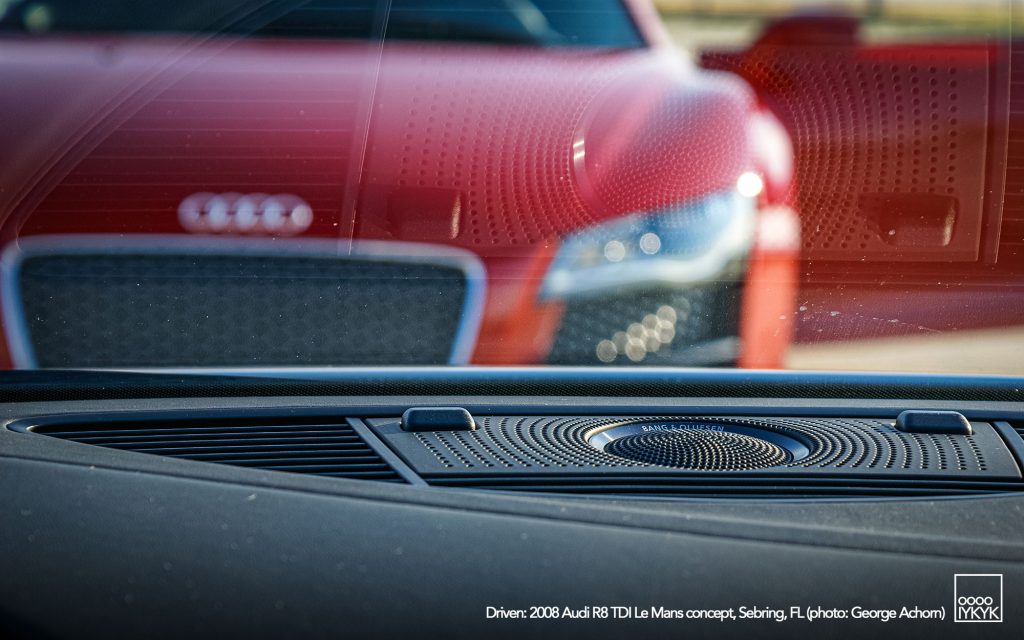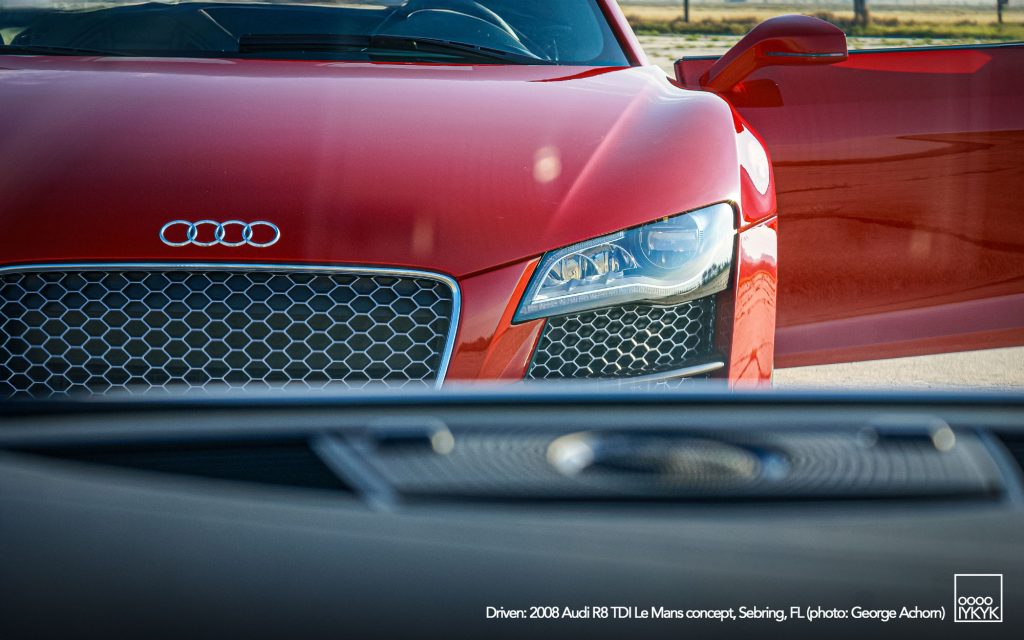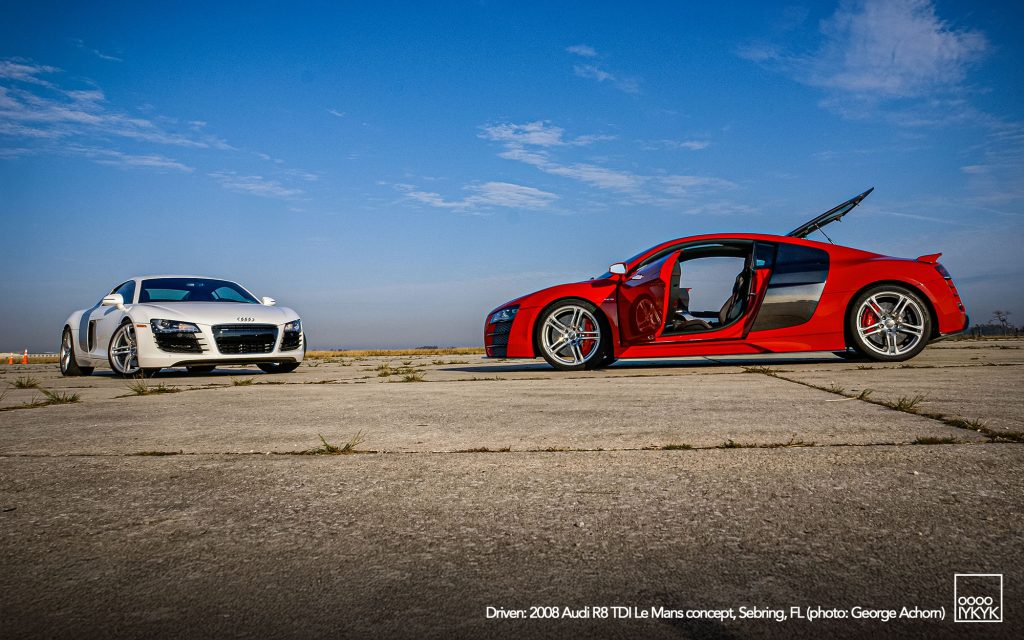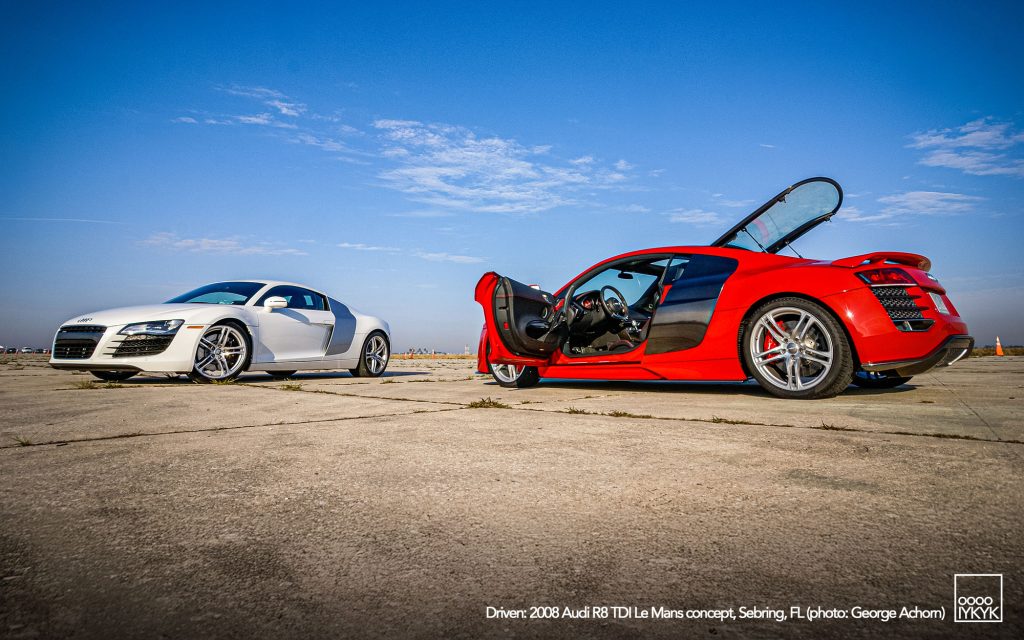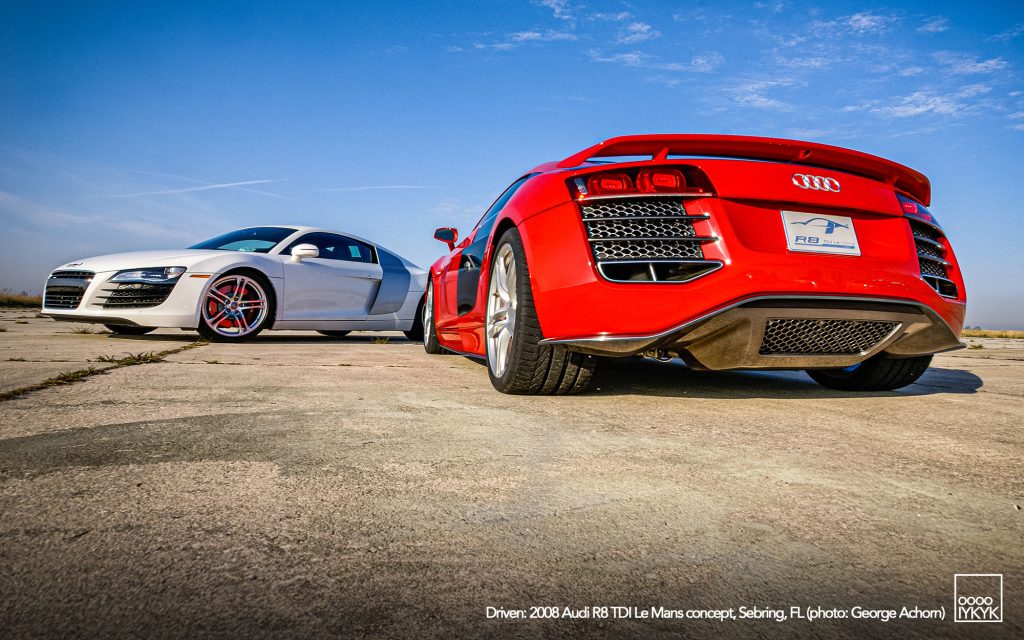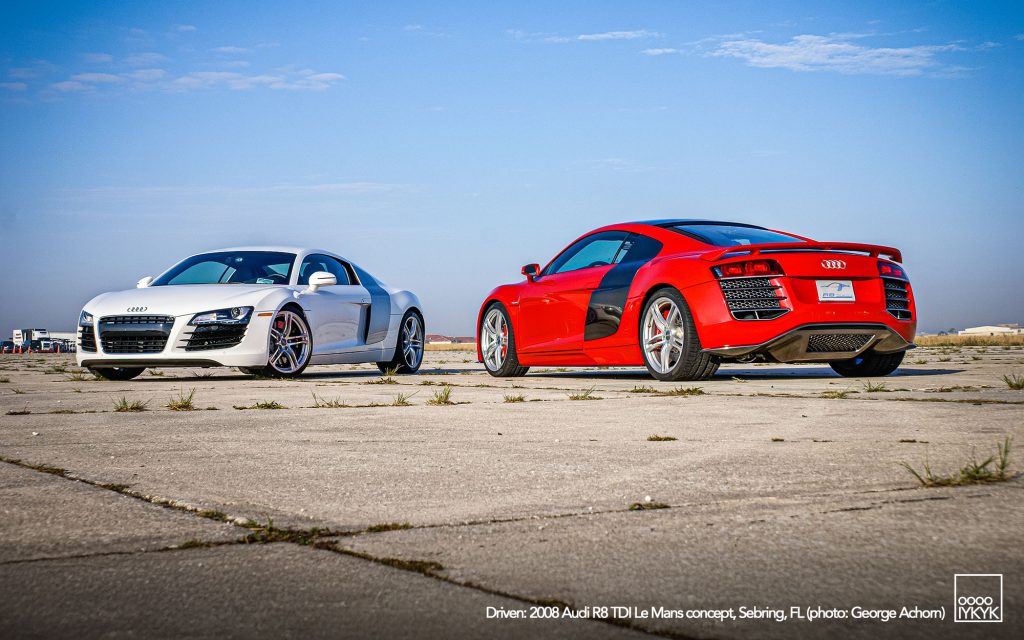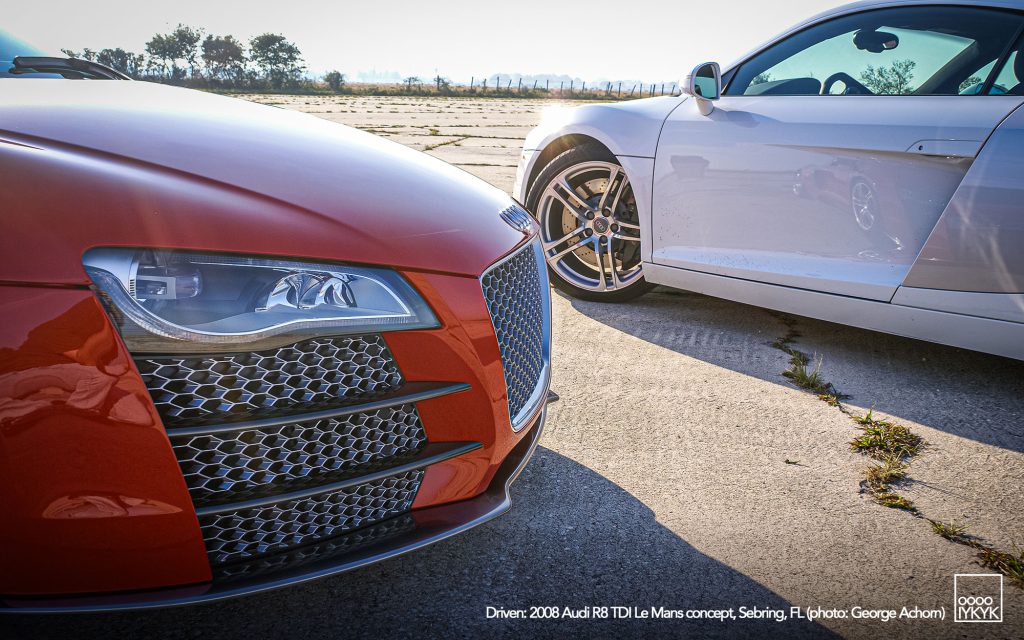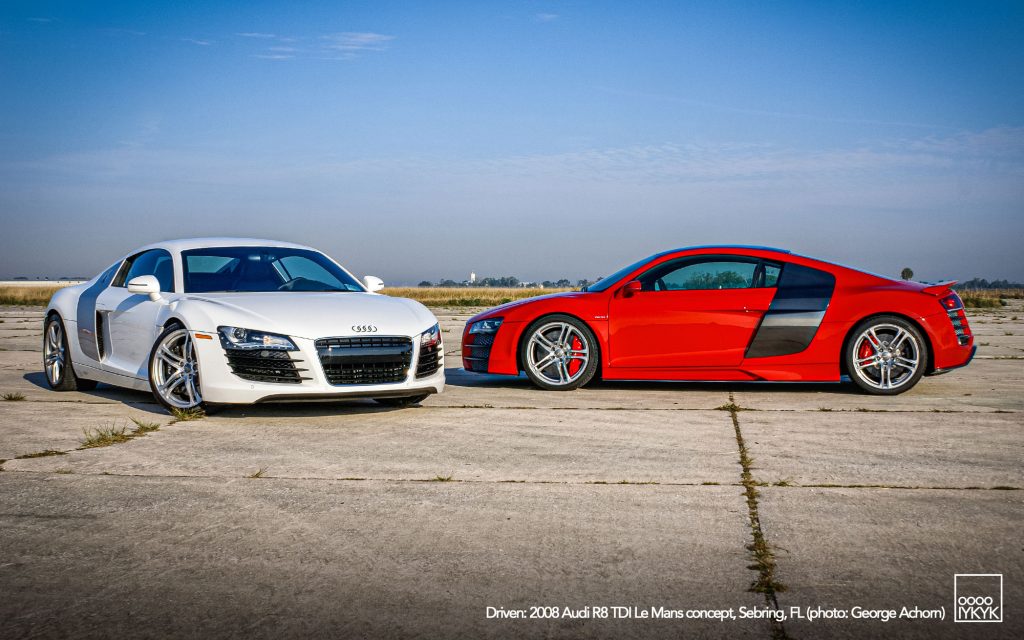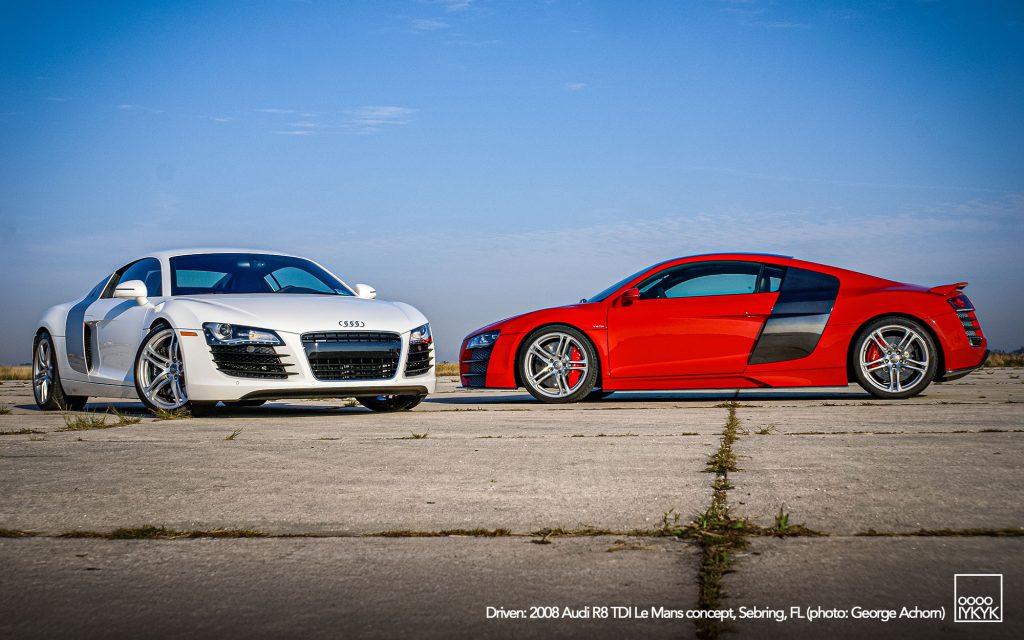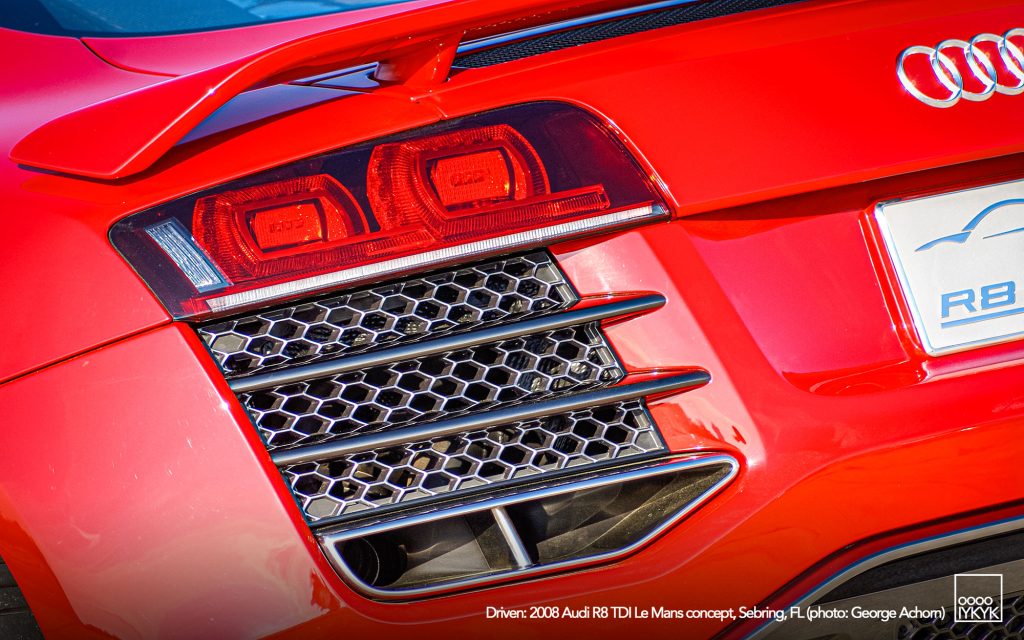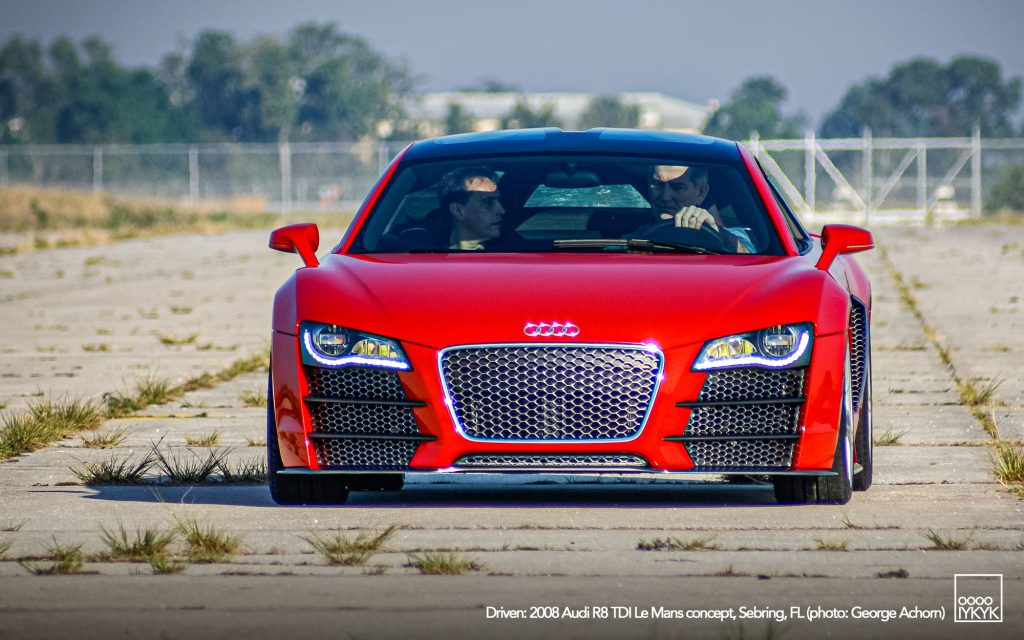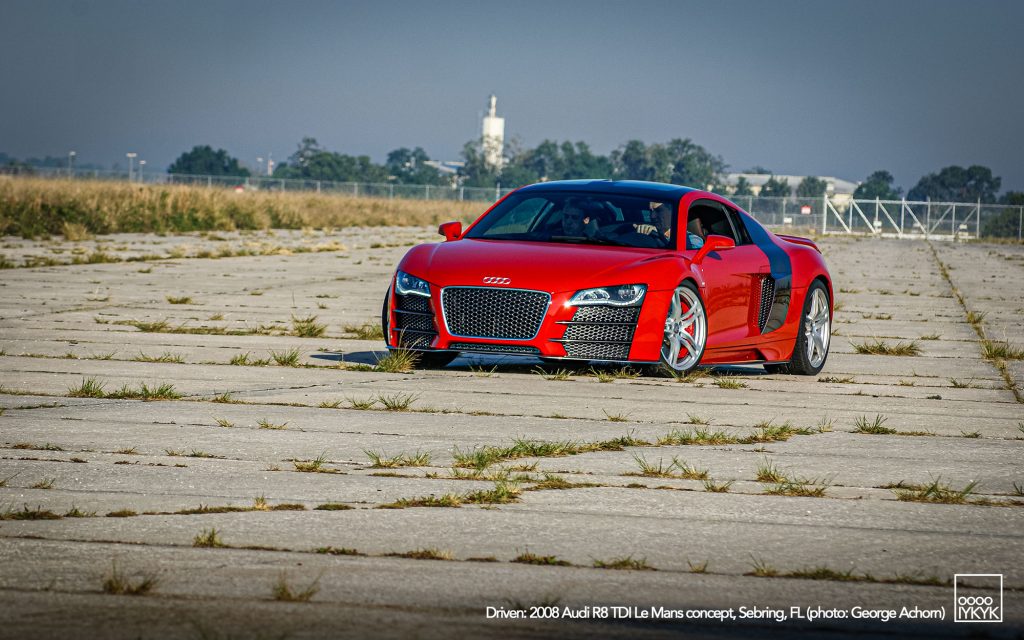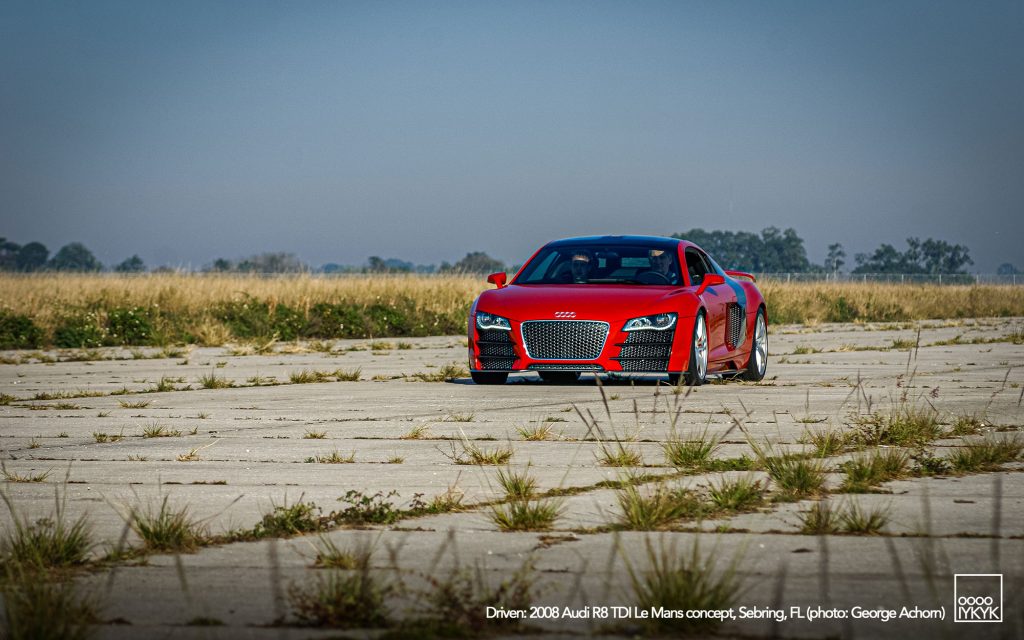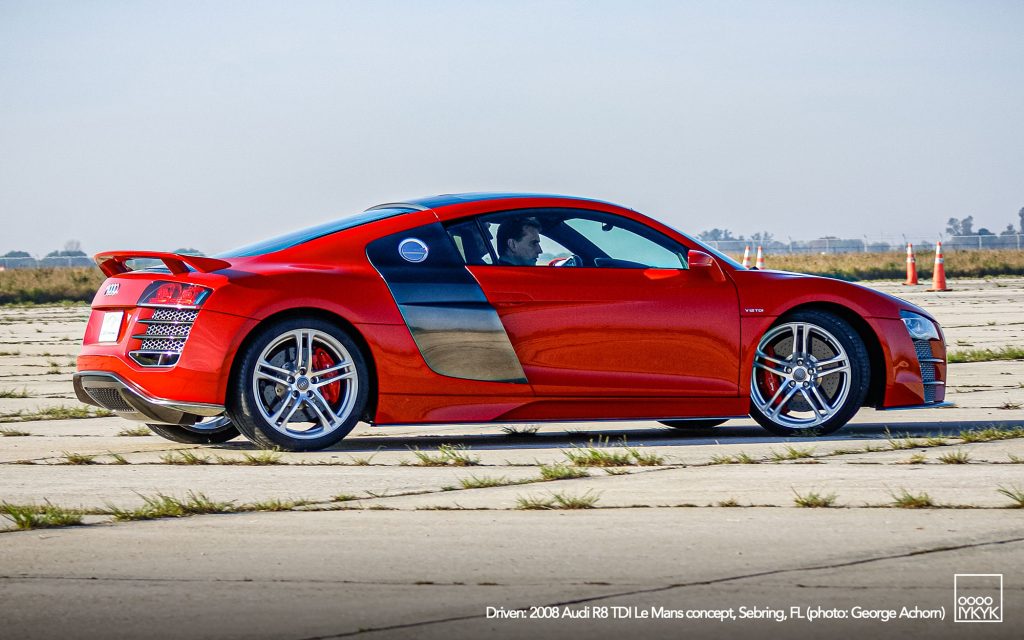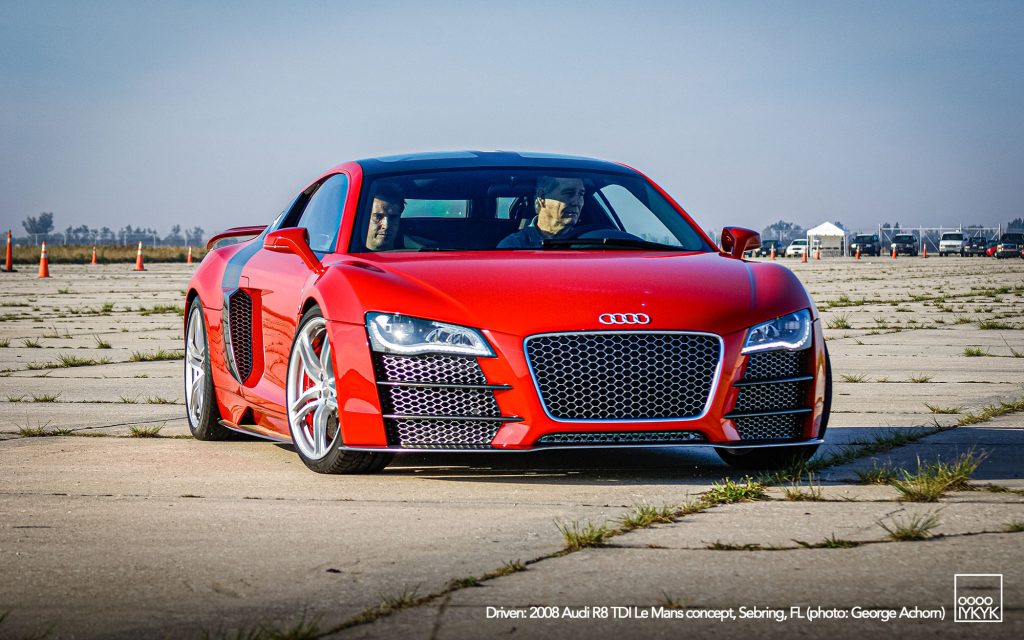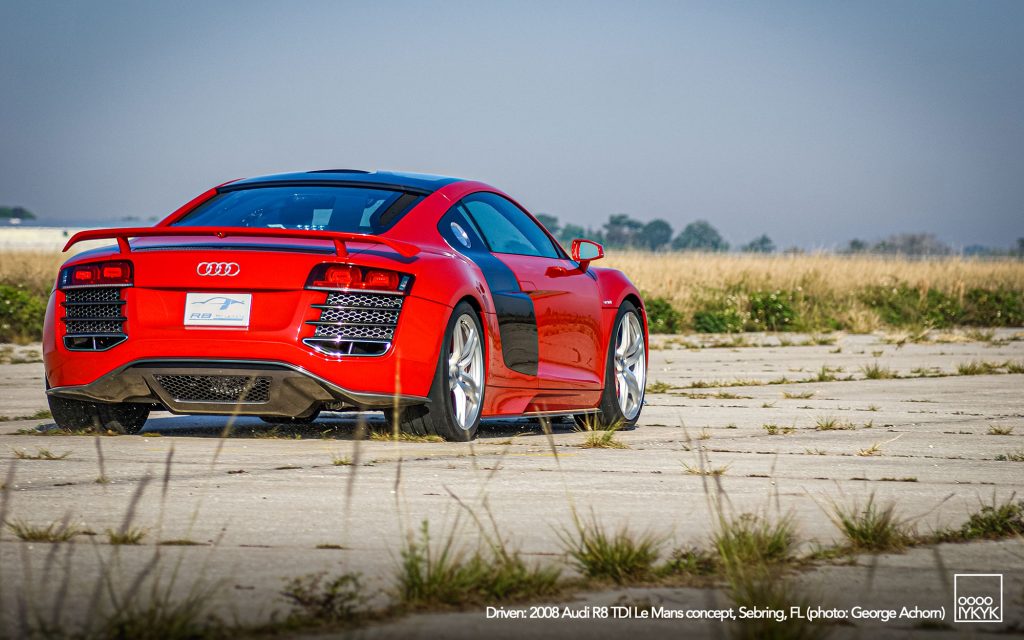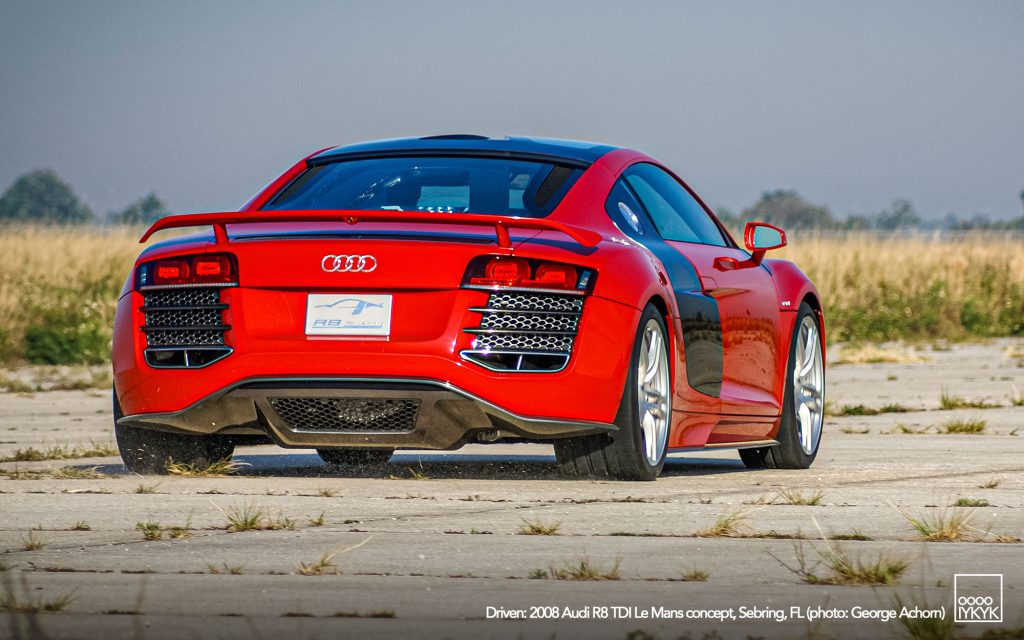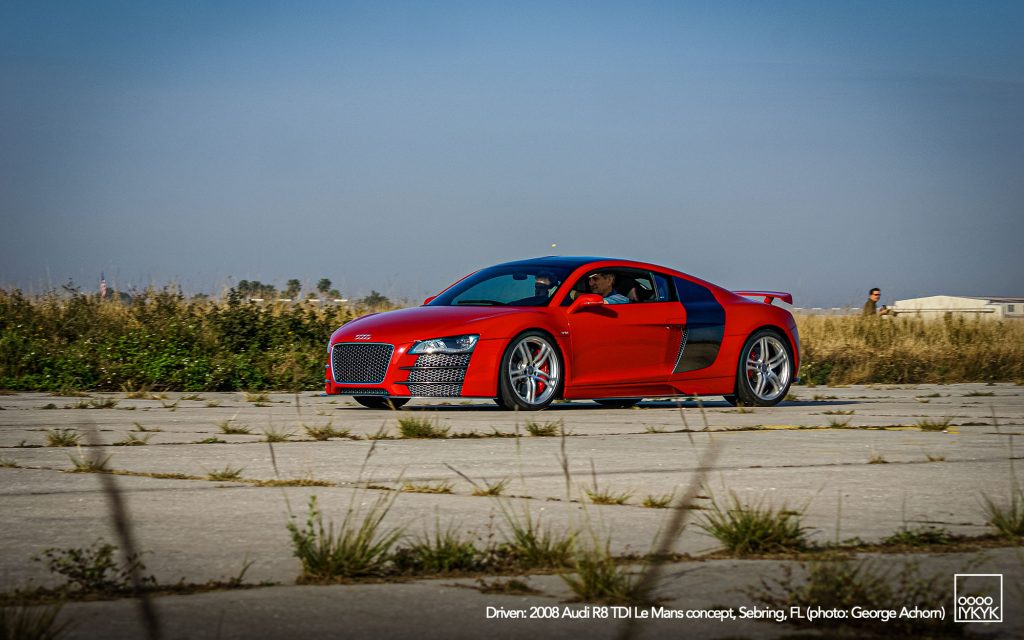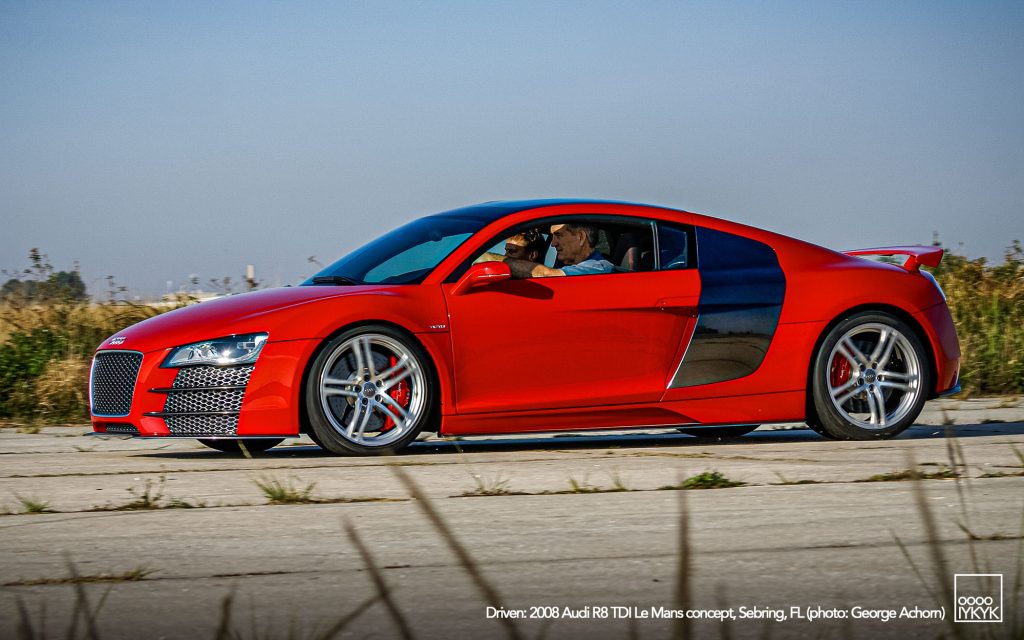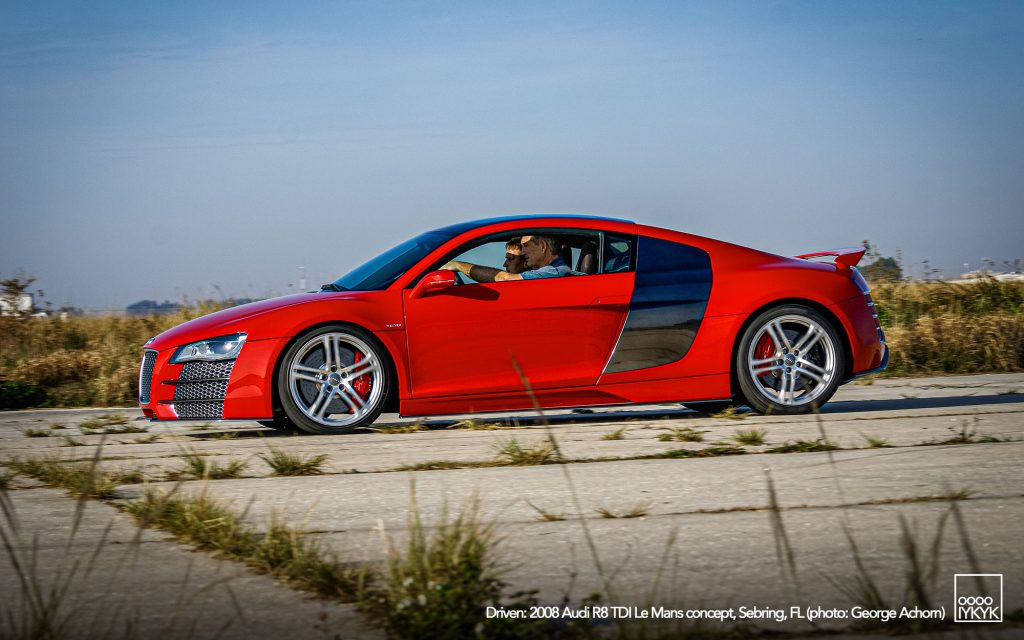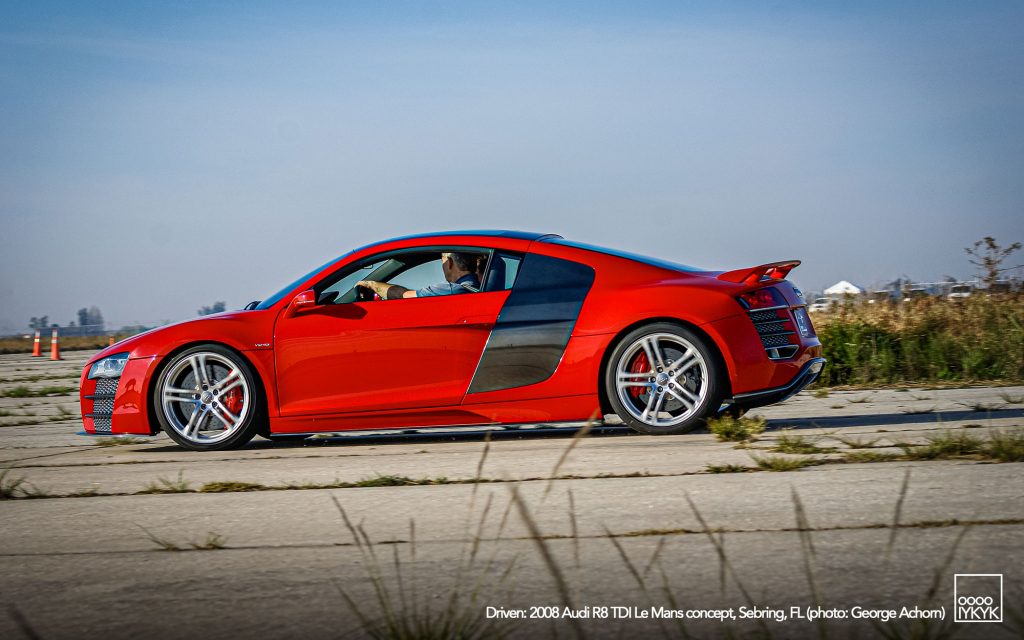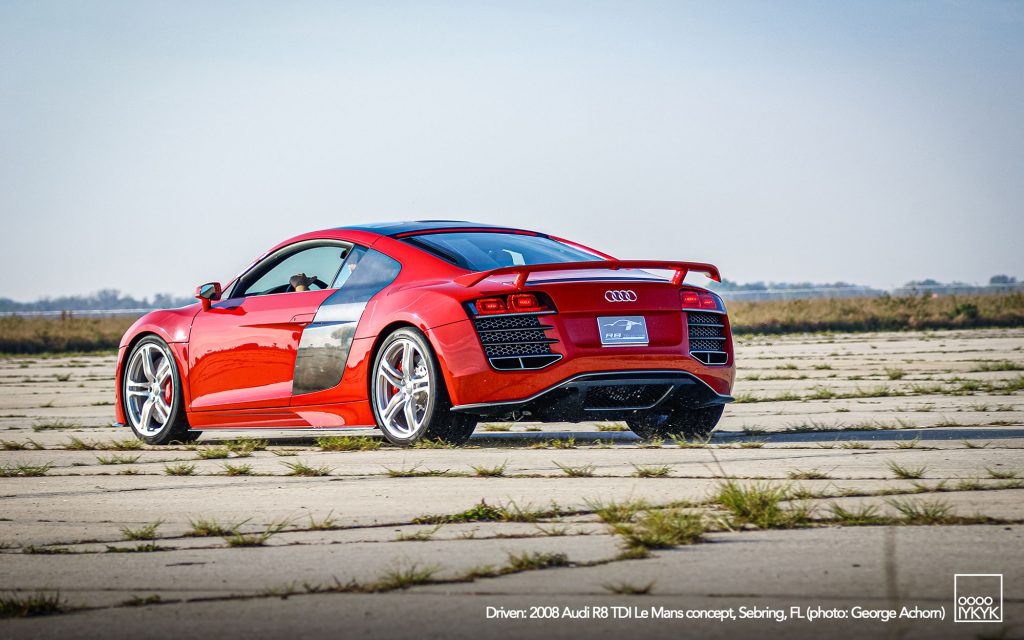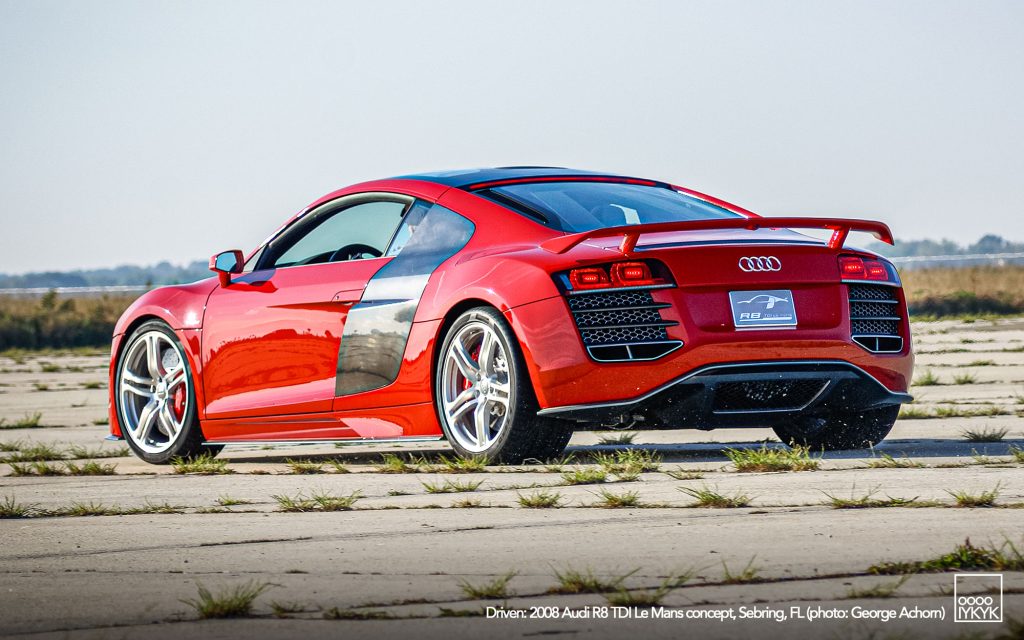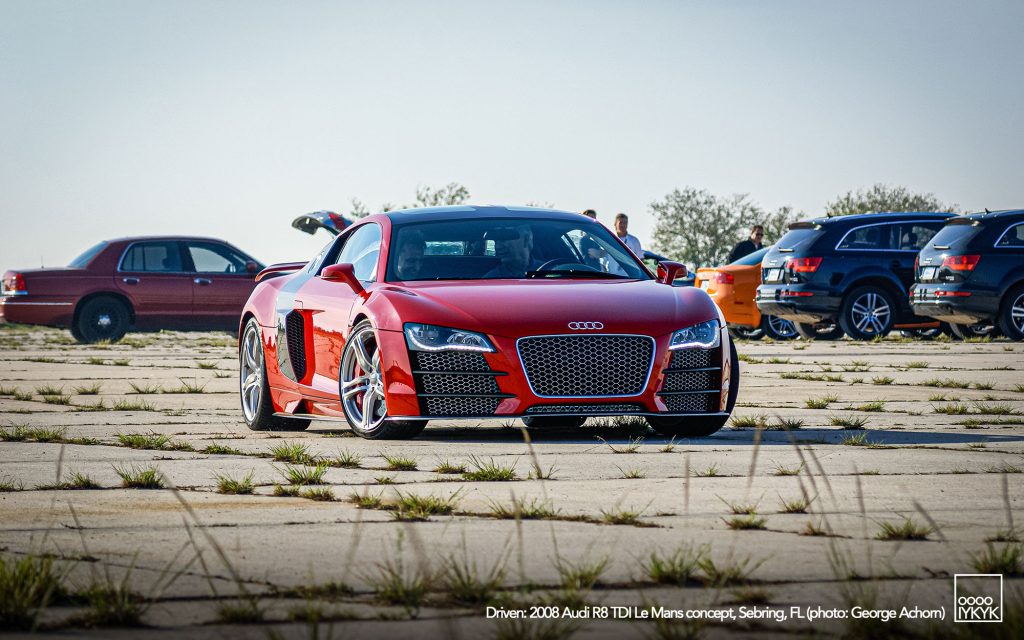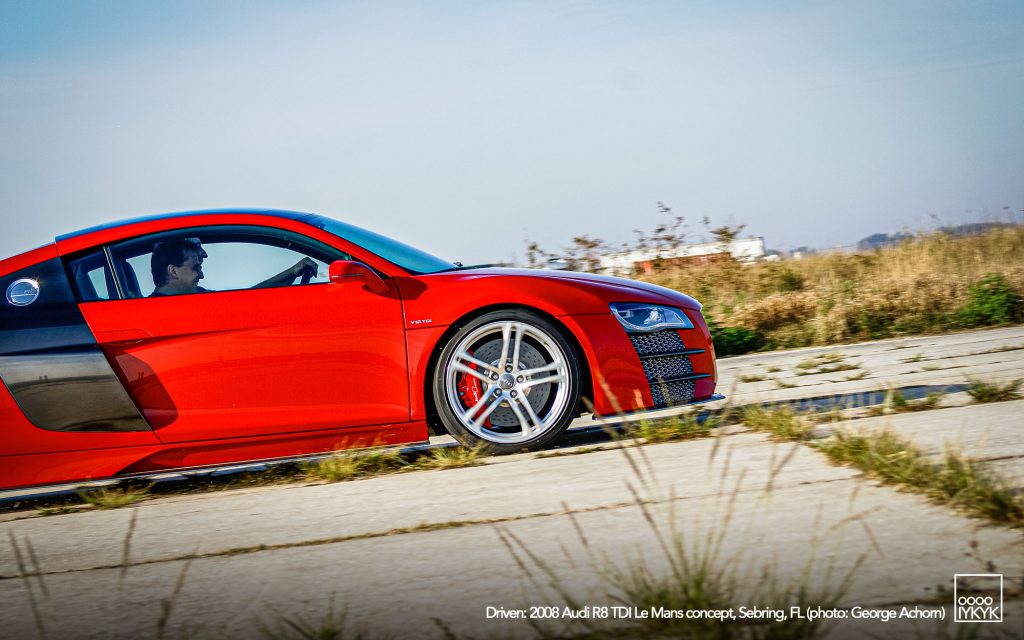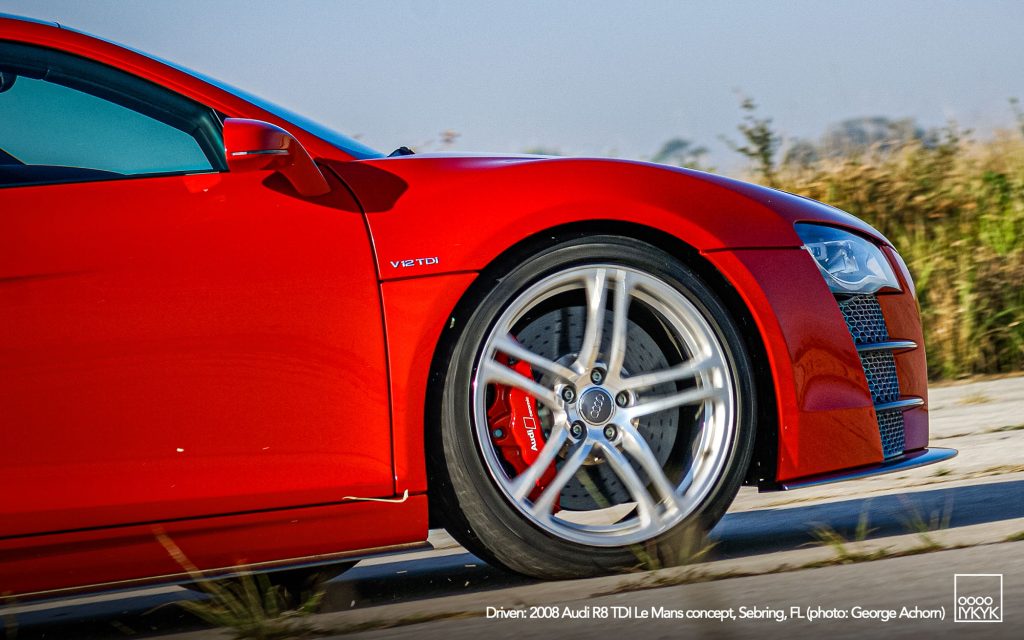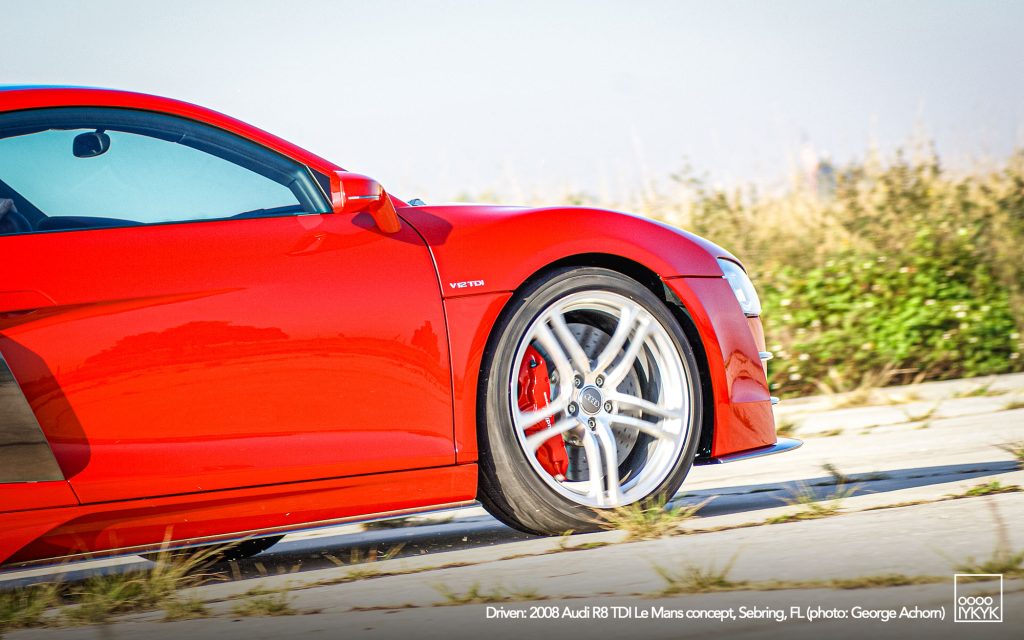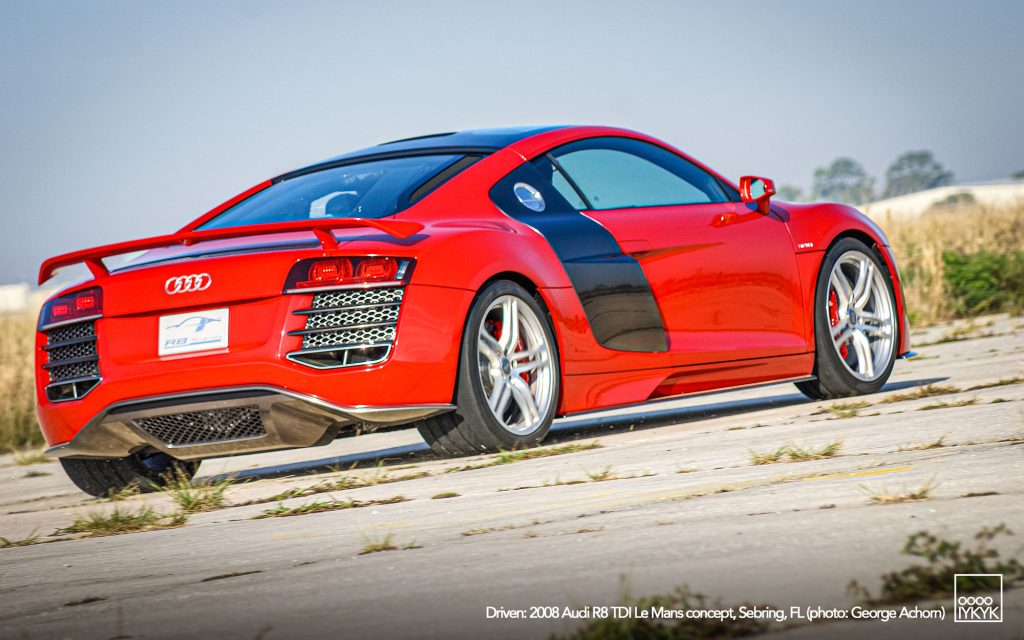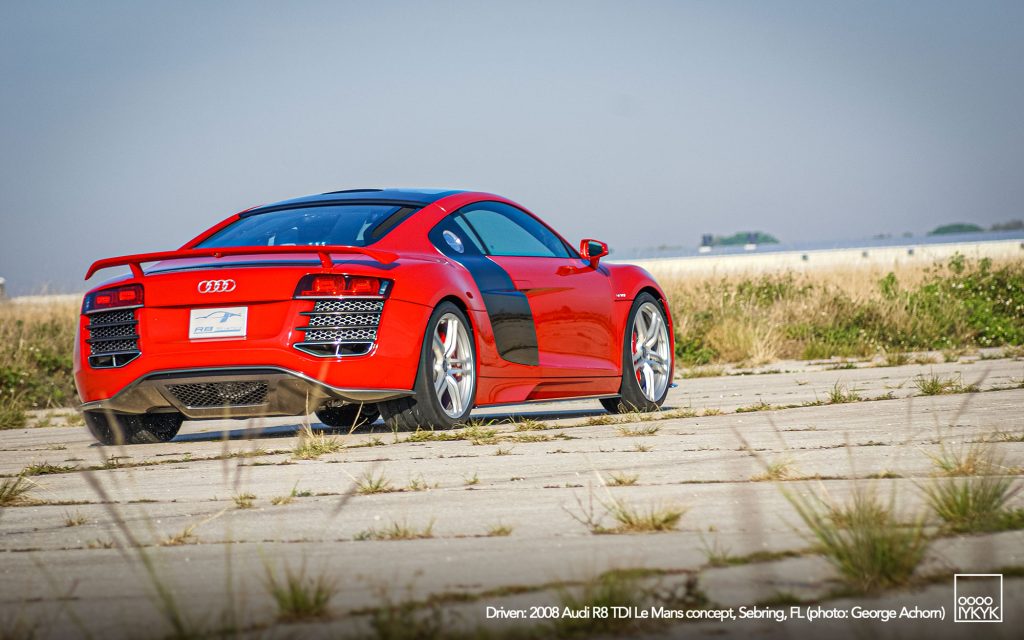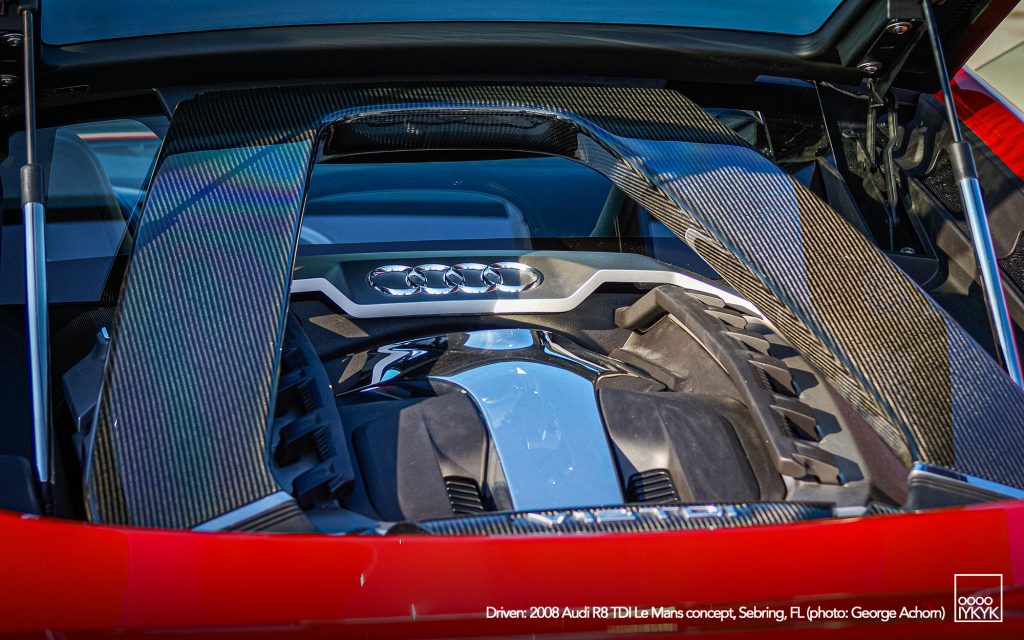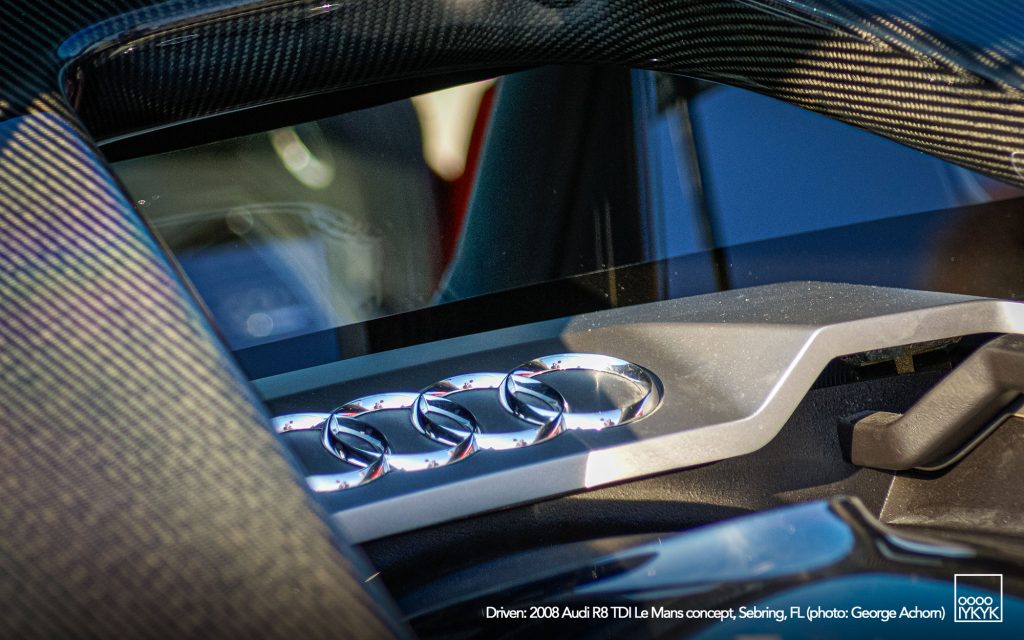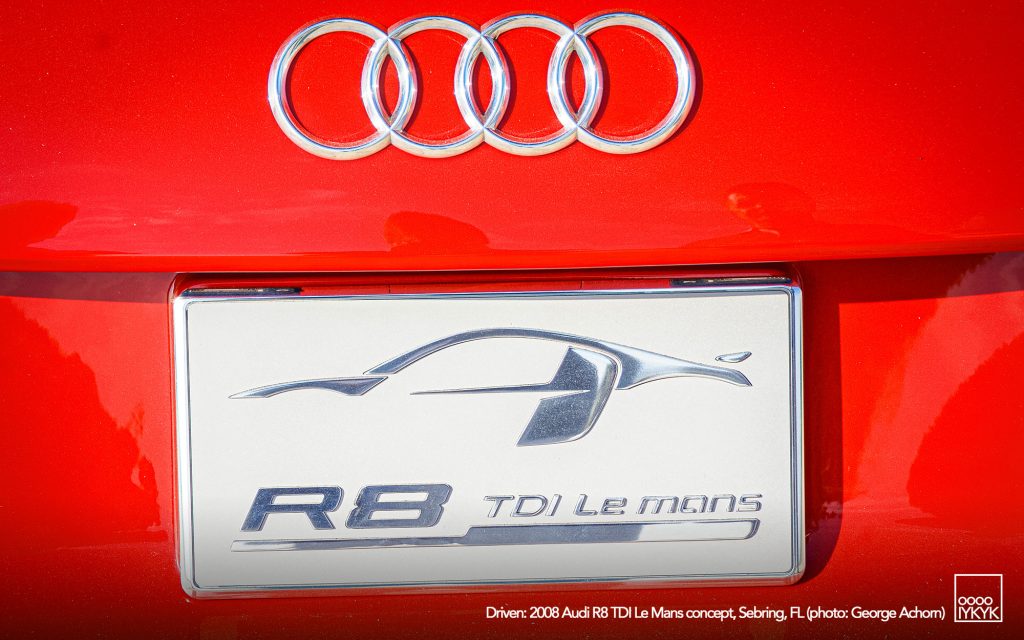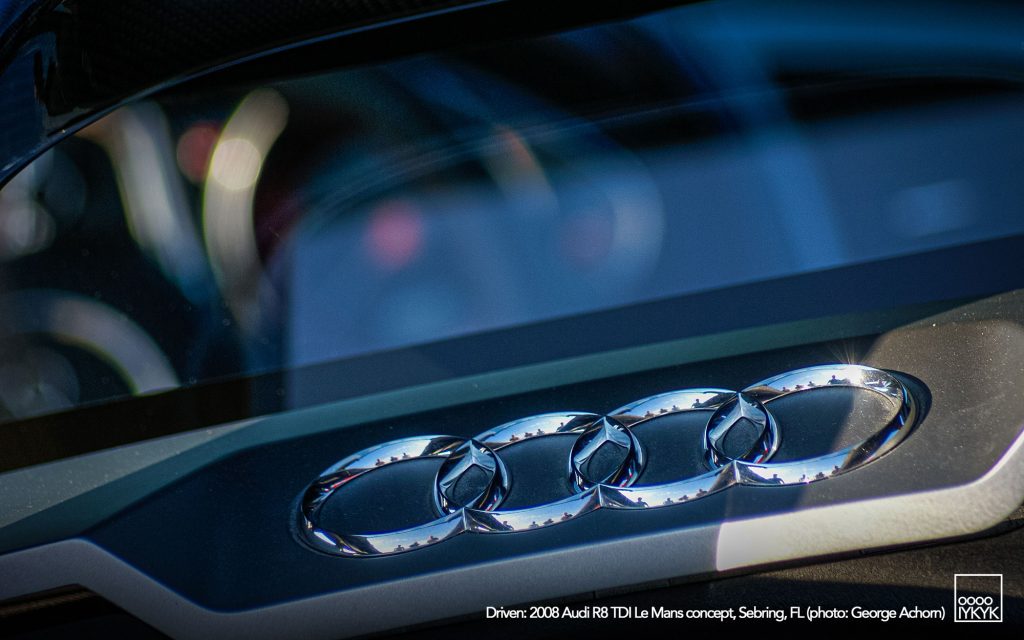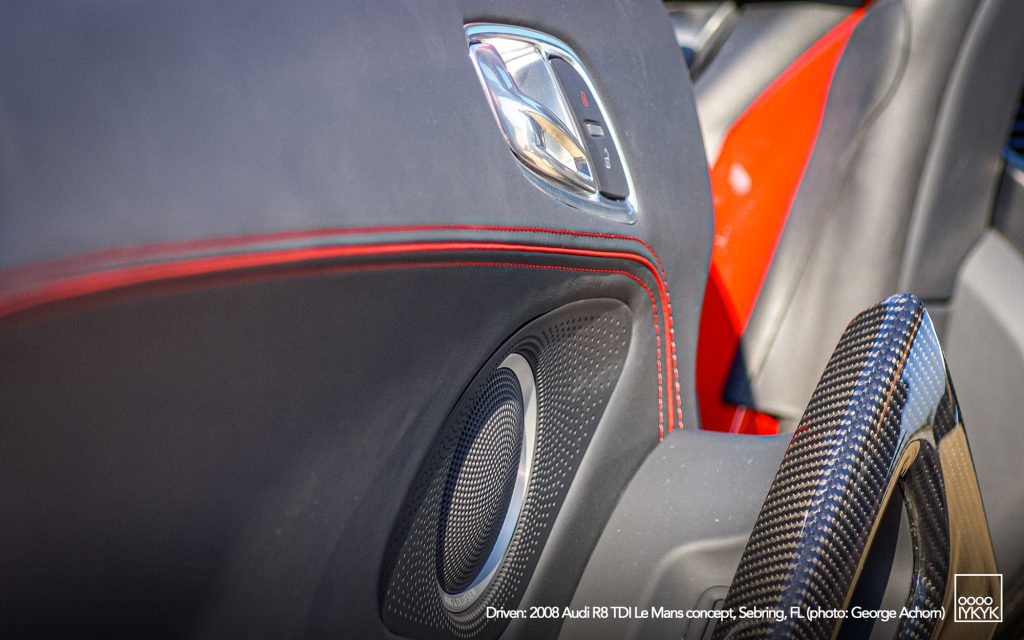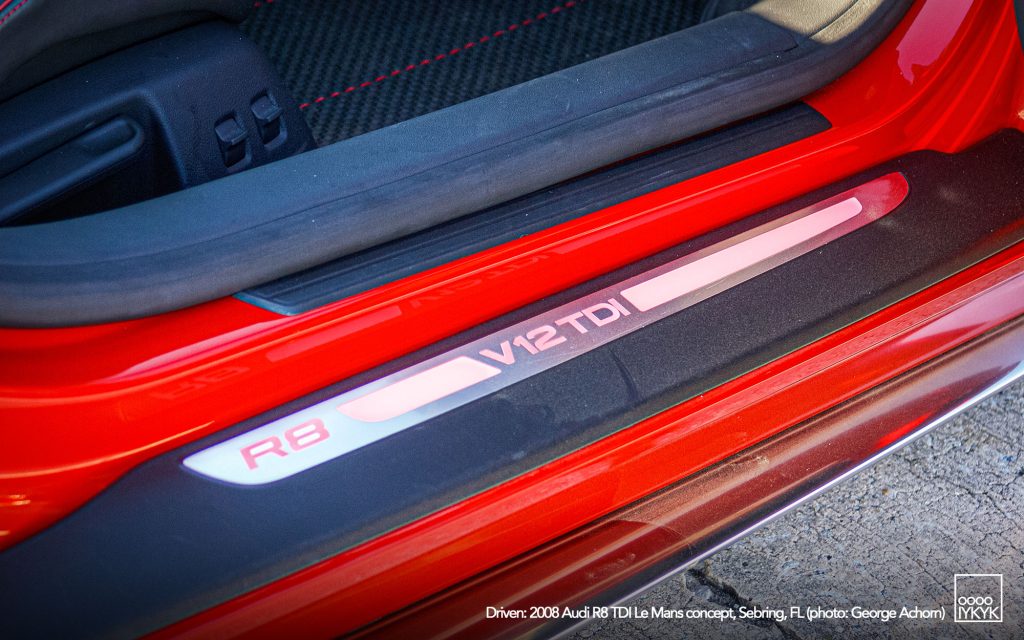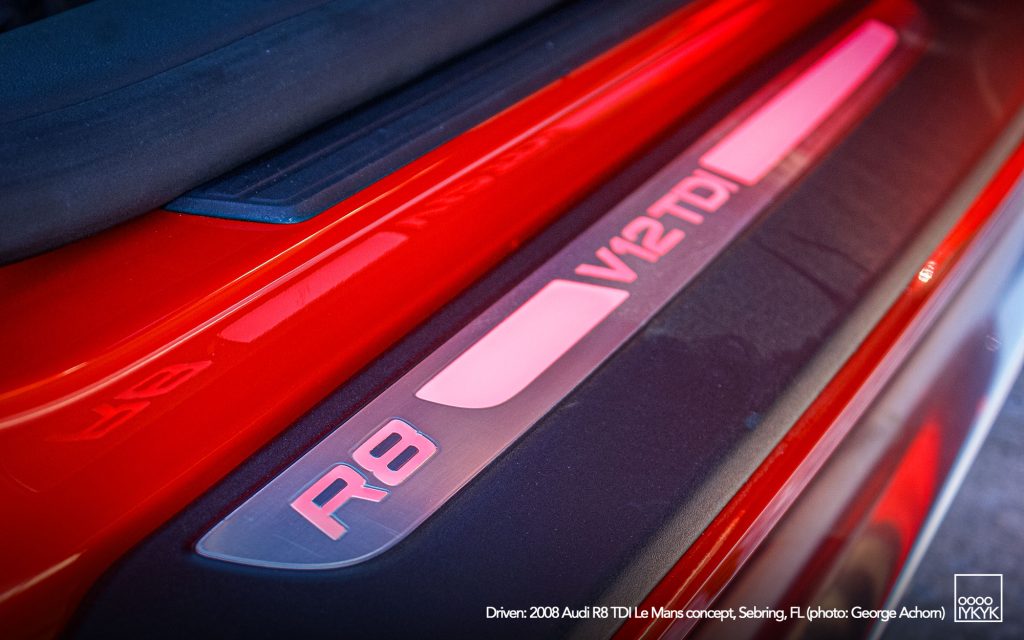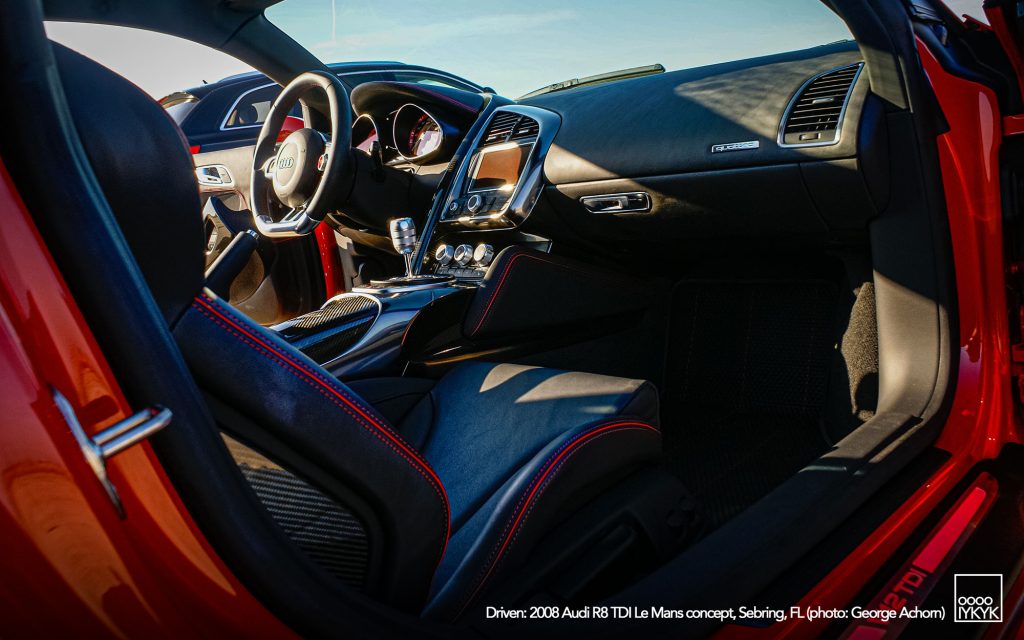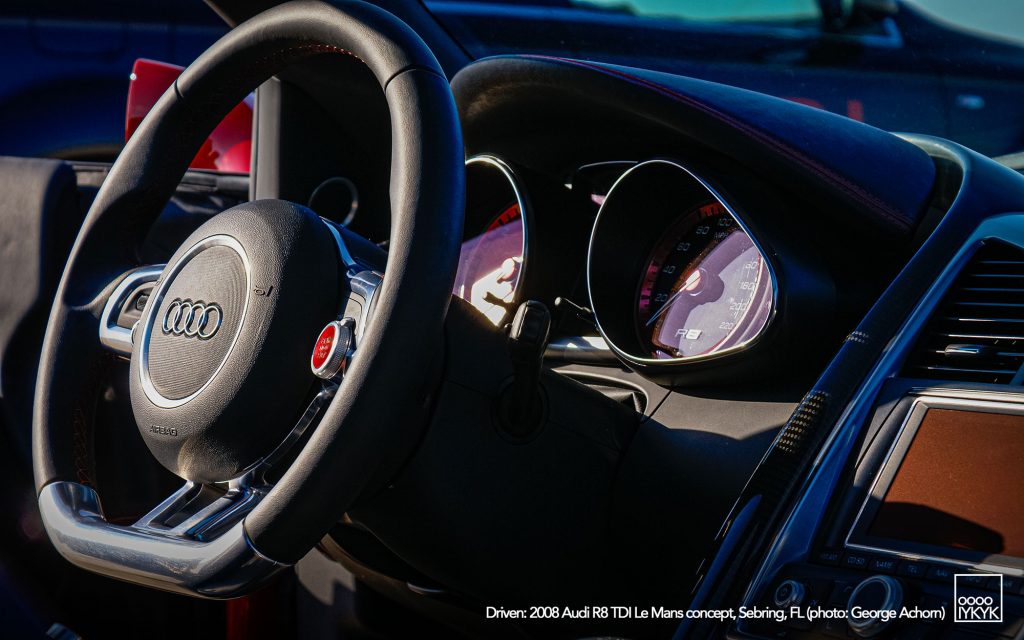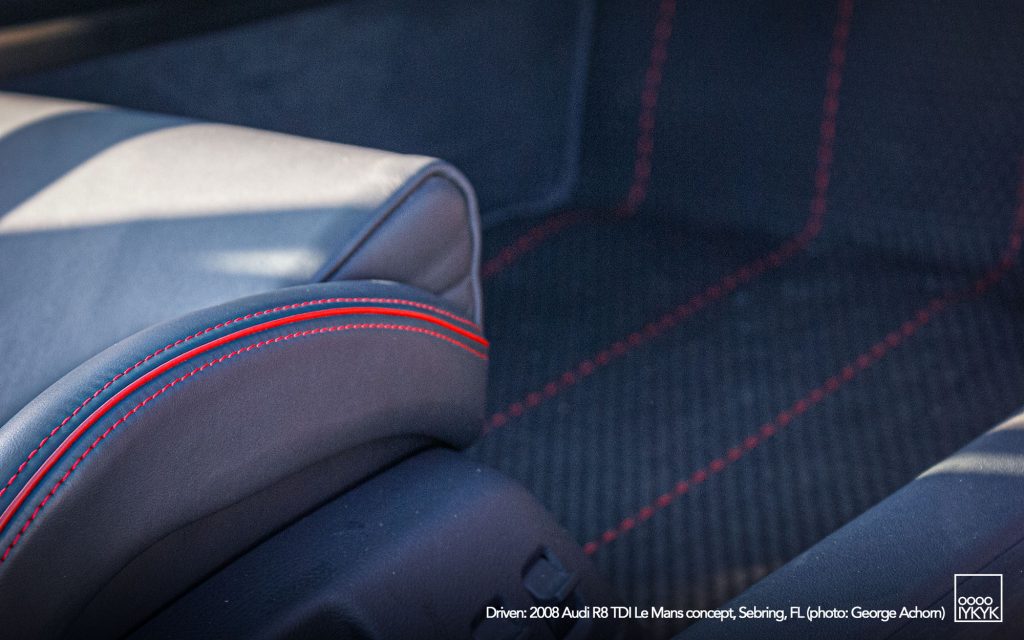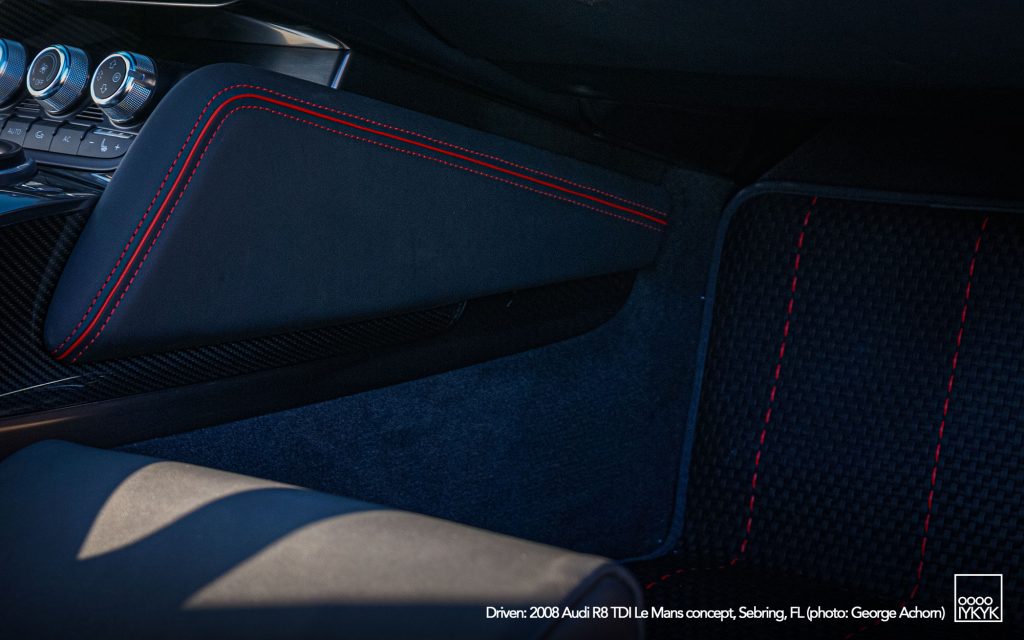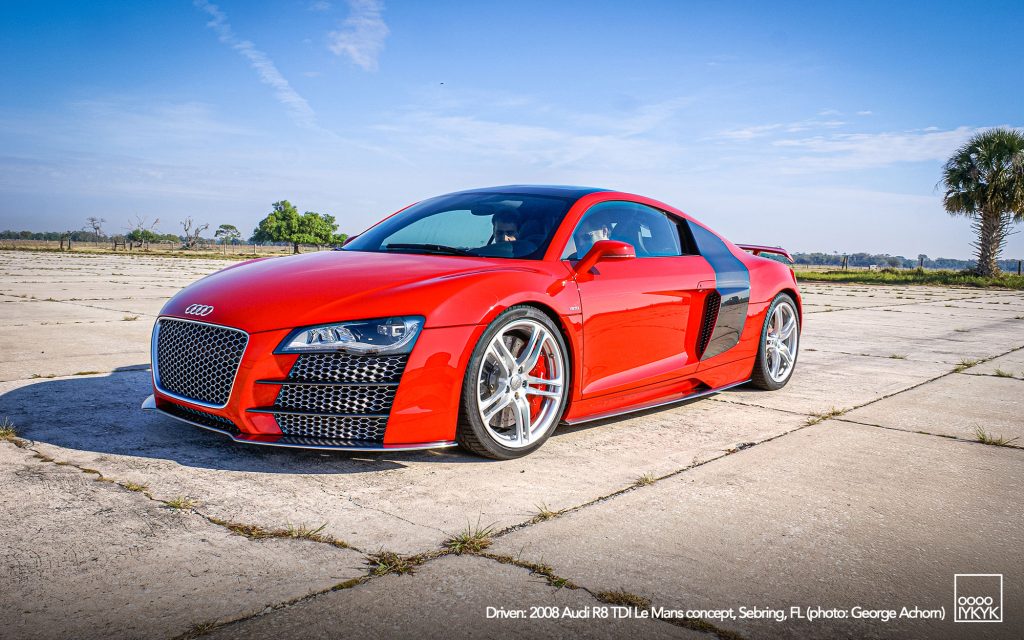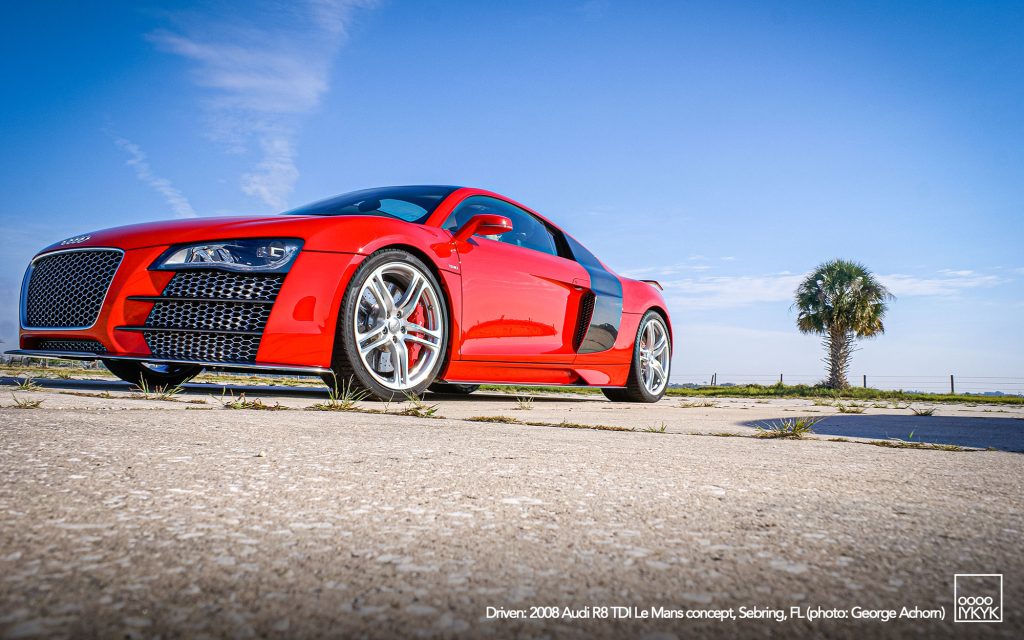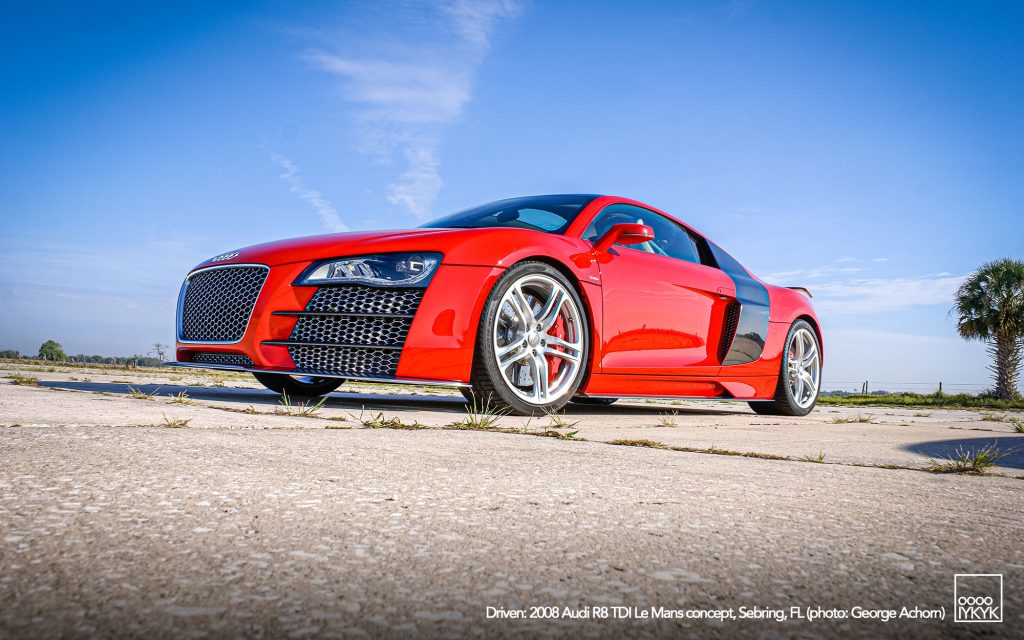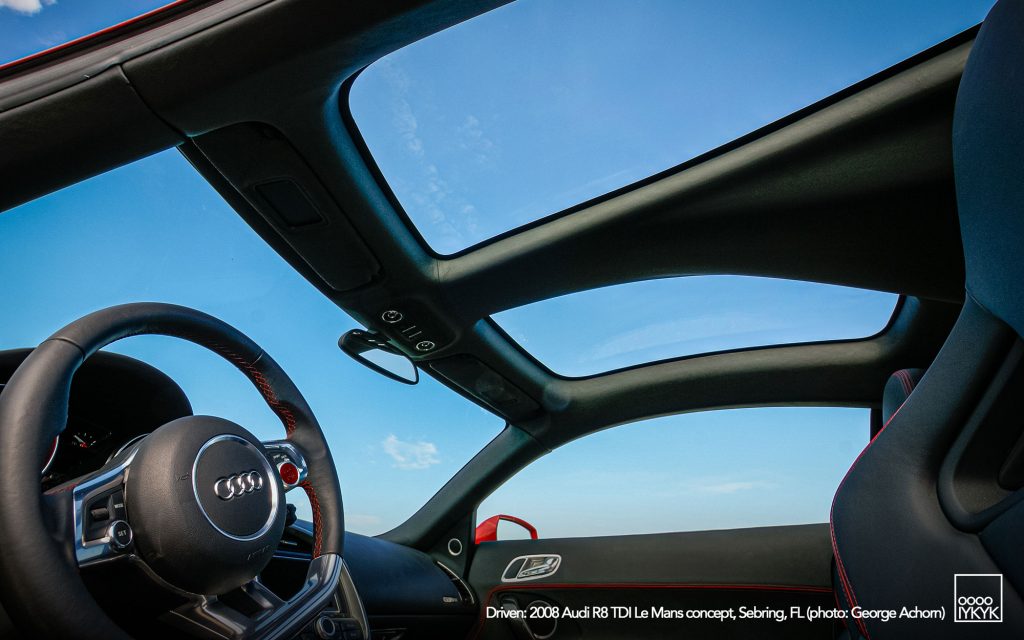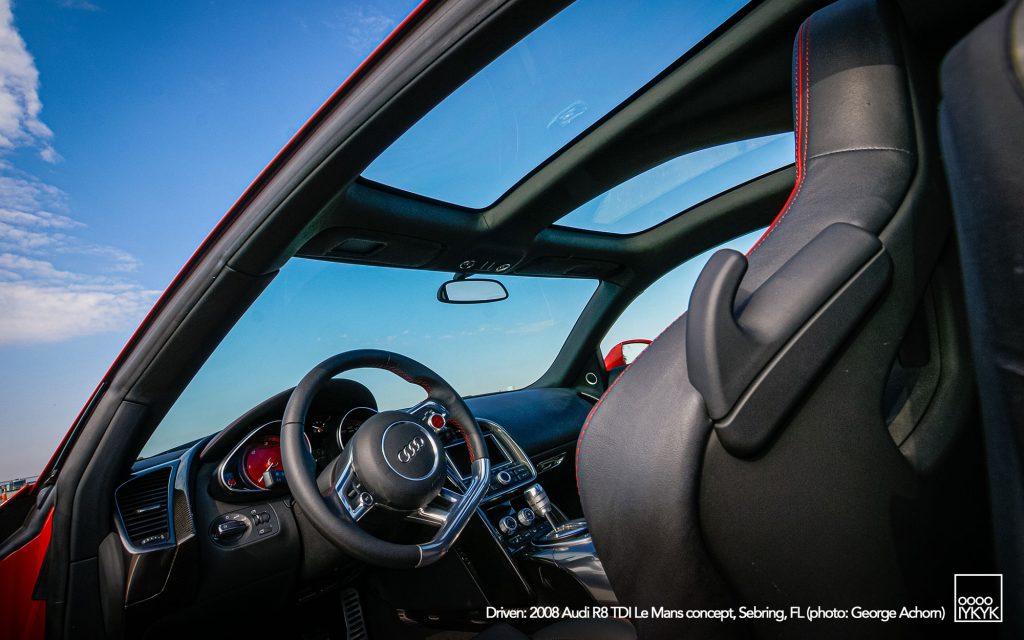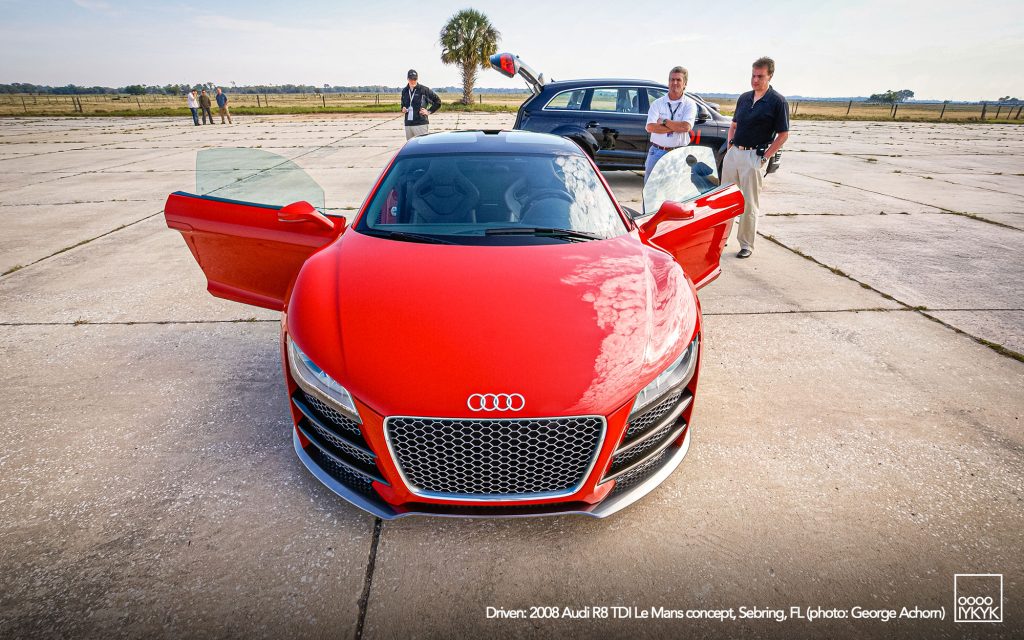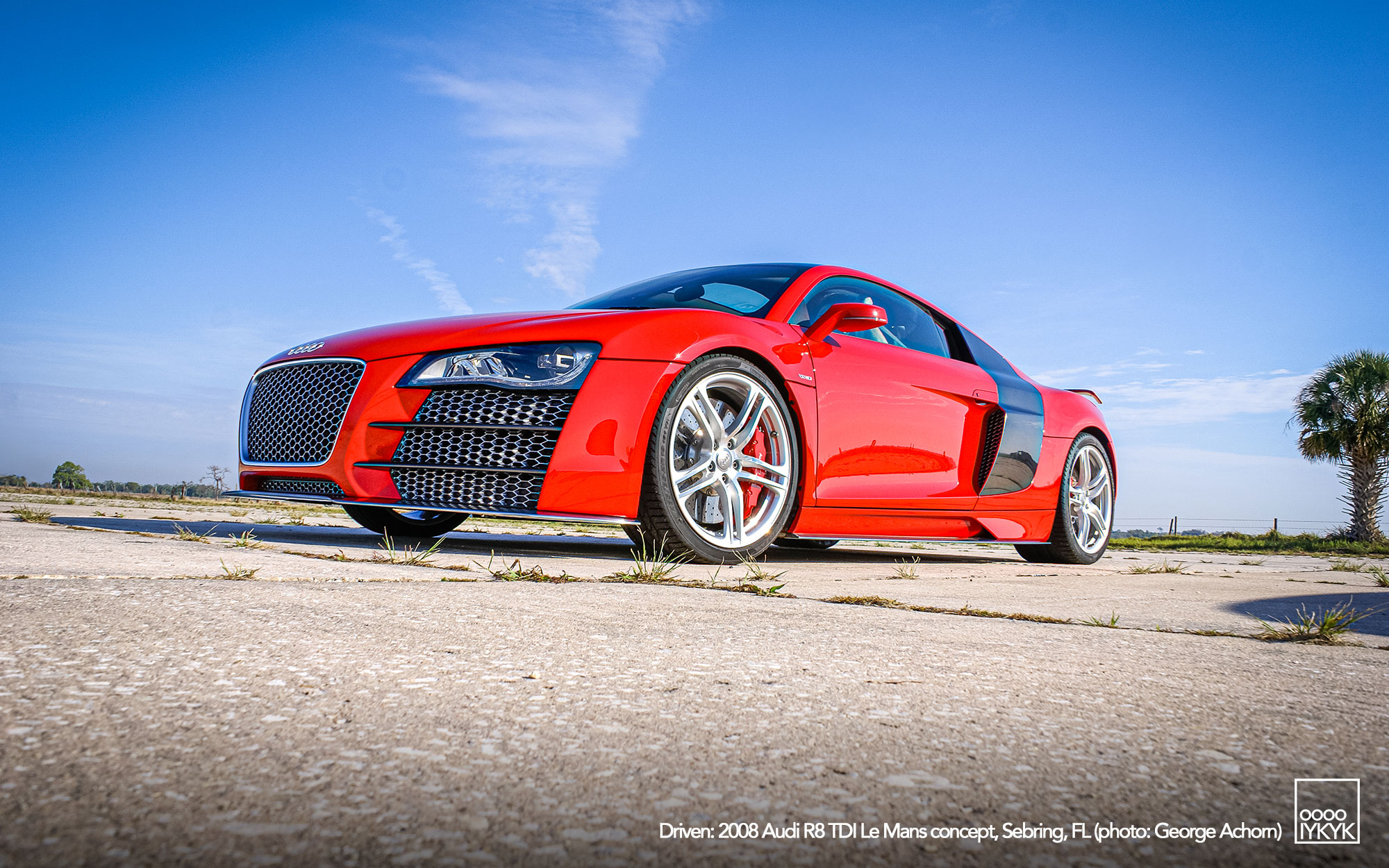Editor’s Note: This summer, the Audi museum mobile features a temporary display celebrating the history of the R8. One of the cars on display is the 2008 R8 TDI Le Mans concept, a bonkers concept car that I actually had a chance to drive in March of 2008. Given the museum’s revisiting of the concept, I decided to also revisit the car in my own way – retelling the driving experience and building out the car’s section in the ooooIYKYK Archive.
Sebring, FL – It was morning at an old and barren portion of airport tarmac that adjoins the Sebring International Raceway. They say Sebring Raceway’s punishing pavement utilizes parts of an old-World War 2 era military airfield, and the ancient concrete surrounding me certainly seems to fit that bill. In front of me was a concept car that had just been shown at the Geneva Motor Show a week prior – the Audi R8 TDI Le Mans concept.
I was in town to cover Audi and their R10 TDI LMP1 cars contest the 12 Hours of Sebring and word from a friend at Audi was that if I wandered a mile or so down the road I might take a quick spin in the diesel-powered, mid-engine R8 supercar that I’d seen in Switzerland the prior week.

SIDENOTE
Want to see more of what Audi revealed about the R8 TDI Le Mans concept? Check out the full press release, press photos and exclusive shots from the show in the ooooIYKYK archive HERE.
After closing out press days at Geneva’s PalExpo, Audi had packed it away and air-freighted it to Florida in order to display it at the race where their Le Mans winning R10 TDIs would vie for another Sebring victory. Before they set it into place though, a very few were going to get to run it down some tarmac. It seems I’d made the cut.
That’s how the crimson R8 Le Mans with its V12 TDI came to sit before me, awaiting some quick frottage – just enough to see the potential, though not enough to jeopardize the one-off prototype. The car was still a concept, which meant two things: First, it’s hadn’t undergone the battery of tests that production cars do and, second, its build cost were more than my insurance company said my life was worth. “Nothing over 50,” instructed the Audi handlers. Good idea.

“Meh”, you say. “What good is such a limited drive?” But, let me ask you – paraphrase rather – in my best Ferris Bueller voice: “If you had the keys to a car like this, would give them back? I didn’t think so.”
It was three years prior at that very track, on that very race weekend that Audi raced into motoring history, driving home a maiden win for the all-new R10 V12 TDI racecar. Only three years, yes, but in that time Audi had put into production the mid-engined R8 and also a V12 TDI engine. Sadly, the two were never paired in actual production form, but I honestly wondered if that was the intention at the time as I considered the scarlet wedge that was basking before me in the south Florida sun.
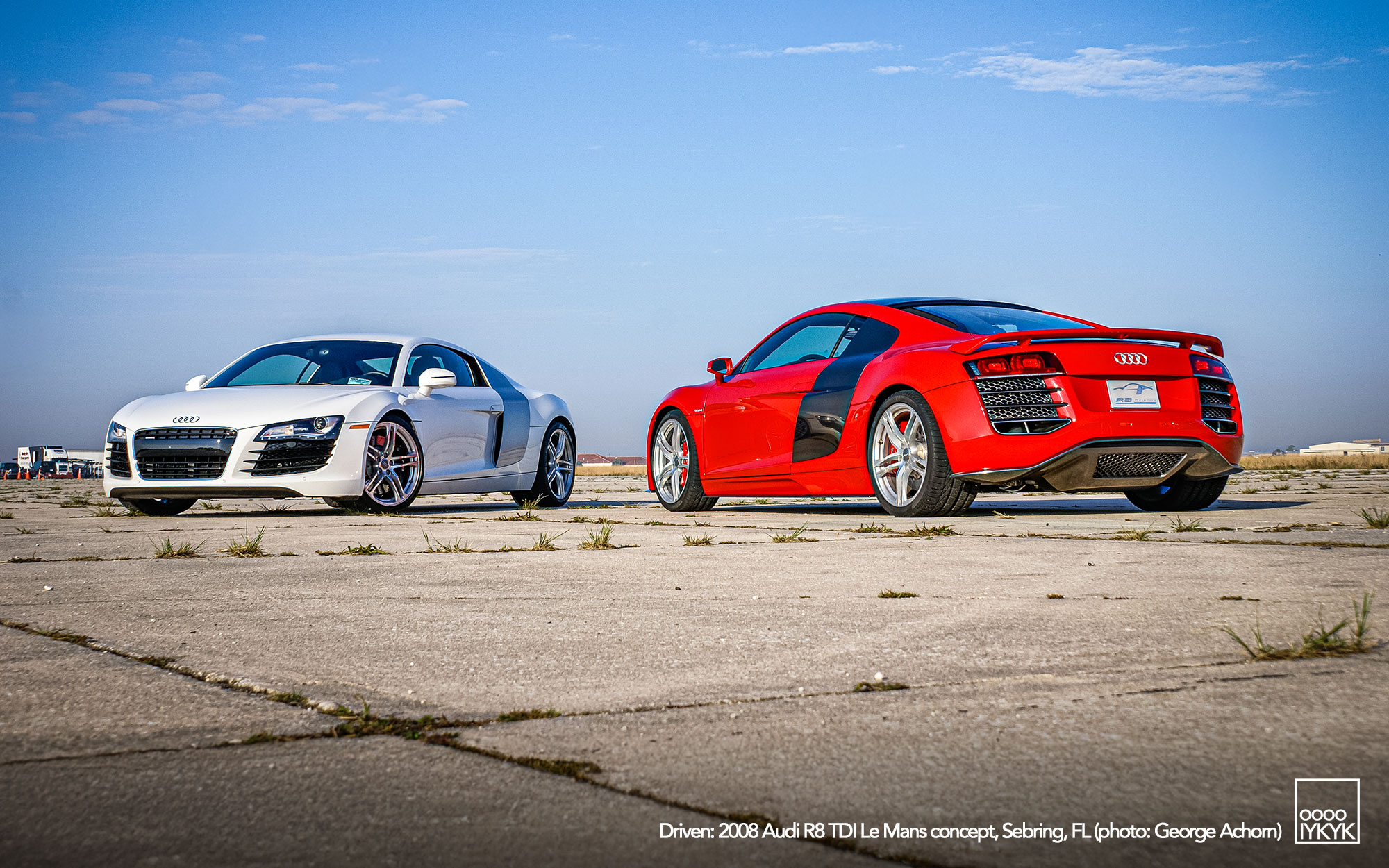
Even before that prototype was color-changed from satin silver as seen in Detroit to brilliant red for display in Geneva, it was clear this was no run-of-the-mill R8. This design study was more aggressive at both front and rear, with more aluminum brightwork – from the unsplit honeycomb grille to trim on the lower fascias and the wedged-out, supercooling version of the R8’s trademark sideblade.
The roof was transparent glass, split by a singular large NACA duct designed to channel air into the V-12’s engine bay, also harking back to a trademark design cue of the 1991 Audi Avus concept car – a car with an equally sizable duct to cool an equally sizable prototype W12 engine.
Like the Avus concept, the R8 TDI Le Mans concept reset the bar, and made the high-revving 4.2-liter production R8, the only engine available in 2008, look somehow lesser. And while even the V10 that would eventually come out was likely faster, it’s hard to imagine how a production R8 V12 TDI would have been upstaged by much of anything when it comes to crowd reaction.
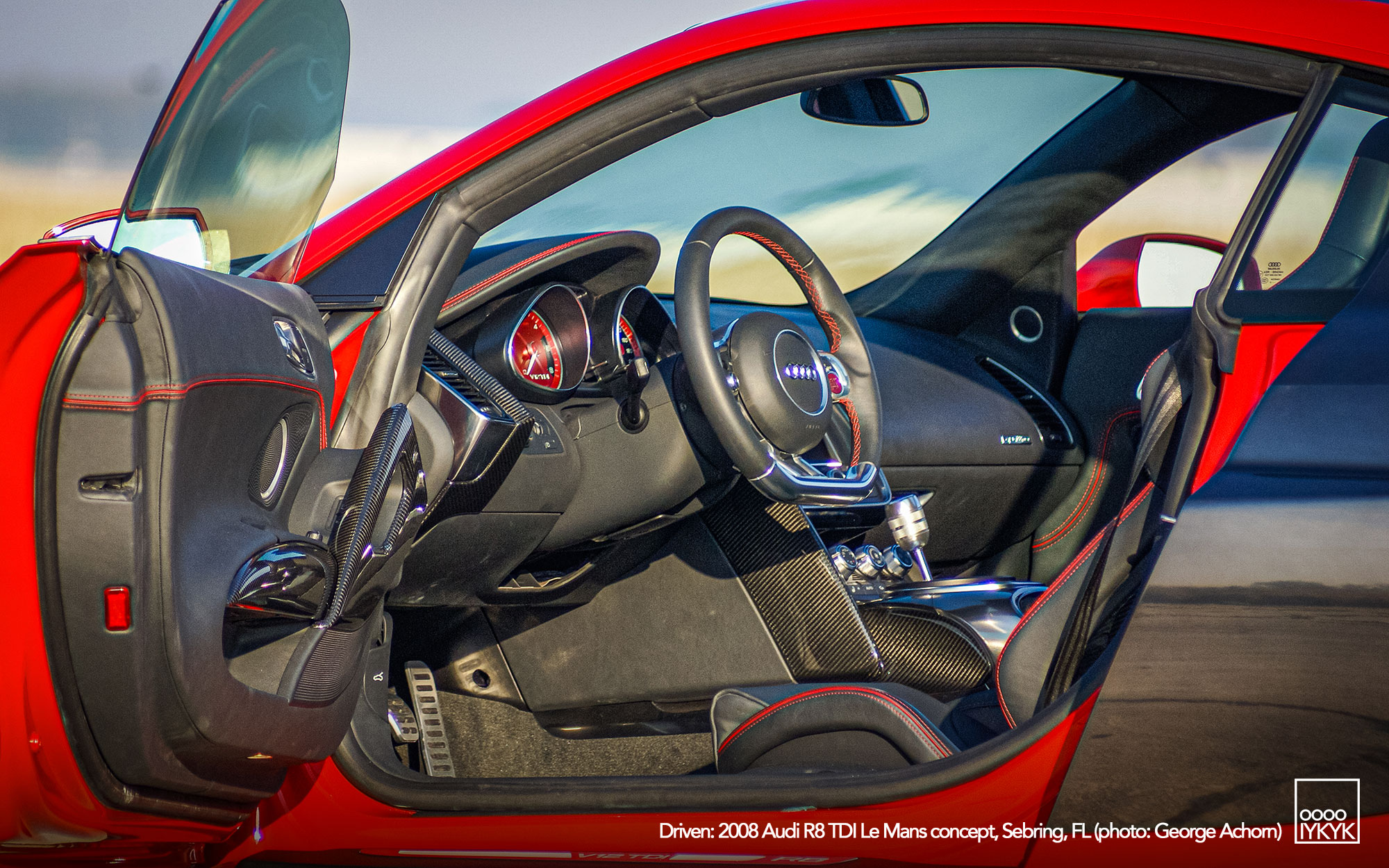
The V12 TDI was a heavy brute of an engine. Notably, it wasn’t some sort of homologation mill – something you might be wondering if you were aware of the R10 TDI racecar. Both the R10 and the R8 Le Mans concept had a V12 TDI, but the similarities begin and end there. The Le Mans’ 6.0-liter street engine was about 150 hp shy of the 5.5-liter race engine output, but with a rating of 737 lb-ft of torque from only 1750 rpm, you could figure it would have shredded pavement with ease.
The Germans on hand told me that it’d also hit 62 mph in 4.2 seconds under full power, with a top speed of 186 mph, before pausing to add that I would not be getting anywhere near that speed on that day. The engine was only running 442 lb-ft for this drive – an effort to keep guys like me from damaging the thing and to increase life of the experimental transmission that’s been custom-built within a case from the Audi A4 parts bin.
Looking at this car in the metal, I had no doubt about critics’ potential concerns, even then, over its environmental impact. For these people, I’d have pointed out that the R8 V12 TDI was projected to provide 24 mpg and meet the then upcoming 2014 Euro 6 emissions standards, thanks to particulate-catching AdBlue system.

Sliding onto the car’s seat, perforated all-black hides with red R8 logos, I was surrounded by enough aluminum accenting to boost Alcoa’s share price. What little storage space there was behind the seats was gone – the firewall had been moved forward to accommodate the V12’s length.
The most noticeable change for the driver was right under my nose – a new flat-bottomed, partially aluminum steering wheel with a magnesium core. We’d eventually see similar designs go into production in the RS 4 B7, with other embedded buttons that would come about in the Mk3 R8 and Mk3 TT.
The anodized red starter button had moved from the dashboard to the 3 o’clock spoke, as was a dial control for the car’s dynamic chassis. Turning the knob to Sport Mode and, in addition to firming up the electrically adjustable dampers and recalibrating the throttle map, the instrument lighting would go from white to red.
This R8’s navigation wasn’t just for finding truck stops with low sulfur diesel either. It also had track layouts and a lap timer function, as well as real-time data like boost pressure and centrifugal force – both lateral forces and acceleration/braking forces.
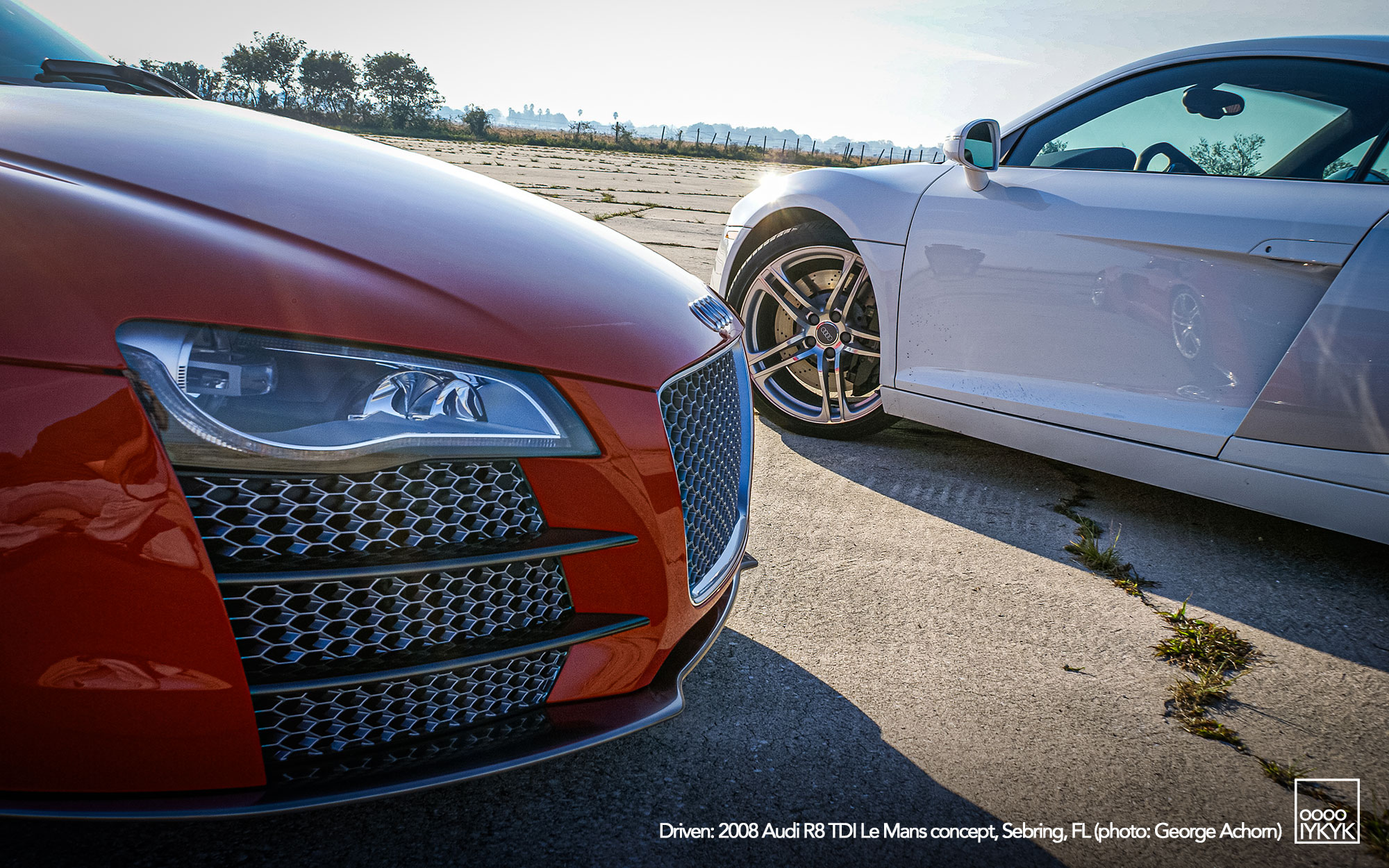
For that moment though, I figured to hell with the technical details. I’d been told I had exactly one half hour with the prototype. All I needed is one hand on the wheel, one on that gated shifter – yup, it’s a manual – and feet positioned for quick use of those three alloy pedals: clutch, throttle, and the stoppers – carbon ceramics, to be precise.
There was no key and no ignition for this prototype. With a foot off the clutch, I pressed the satin-red starter button on the steering wheel once and the car powered up. Depress the clutch and hit it a second time and the V12 fired to life. It was a quiet and subdued rumble with a touch of diesel clatter. If you’ve ever watched an Audi TDI Le Mans car slingshot quietly down a straight in a race, you get the idea.

The noise was almost unexpected in this prototype engine. It was not chattering like a Cummins Ram, but it was more noticeable than Audi’s whispering production TDI engines as seen in Audi’s production diesel cars of the time.
Engaging first gear, I could hear the audible snikt as the shifter entered the gate. Clutch feel seemed decidedly production – linear and light. First gear was short and the TDI’s redline is shorter, so I’m through it quickly even though there was little anger in my launch.
Heavy into the pedal, the sound was like nothing I’d heard before. There was the churn and muffled roar of twelve firing cylinders right behind my head, almost drowned out by the vacuum of air sucking into the car’s enlarged intakes.

Our test track was big and straight – a cement landing strip I’d been told was used during World War II for B-24 Bombers. Grass is growing between the aging cement slabs, in joints that thump smoothly under the R8. Audi staff had done their best to clean an even narrower path down one straight and I’d been asked to do my best to stick to that area.
Cornering in the prototype was limited to spirited turnarounds or zig-zagging down the strip like a racer trying to keep tire temps up under safety car conditions. In doing that, I noted the car’s added girth over the R8 4.2 I’d just driven there, but it was still no brick sled. The V12 TDI prototype had multi-mode Audi Drive Select system and more aggressive tune.
Racing (if you can call 50 mph racing) toward the end of the runway, rev-matching for a downshift caused me to pause momentarily. The revs go up easily but redline is nearly half that of the gas R8, making me think twice as I went down a gear and had me trying to re-set my brain’s ear-based tach from R8 V8 to R8 V12 TDI.
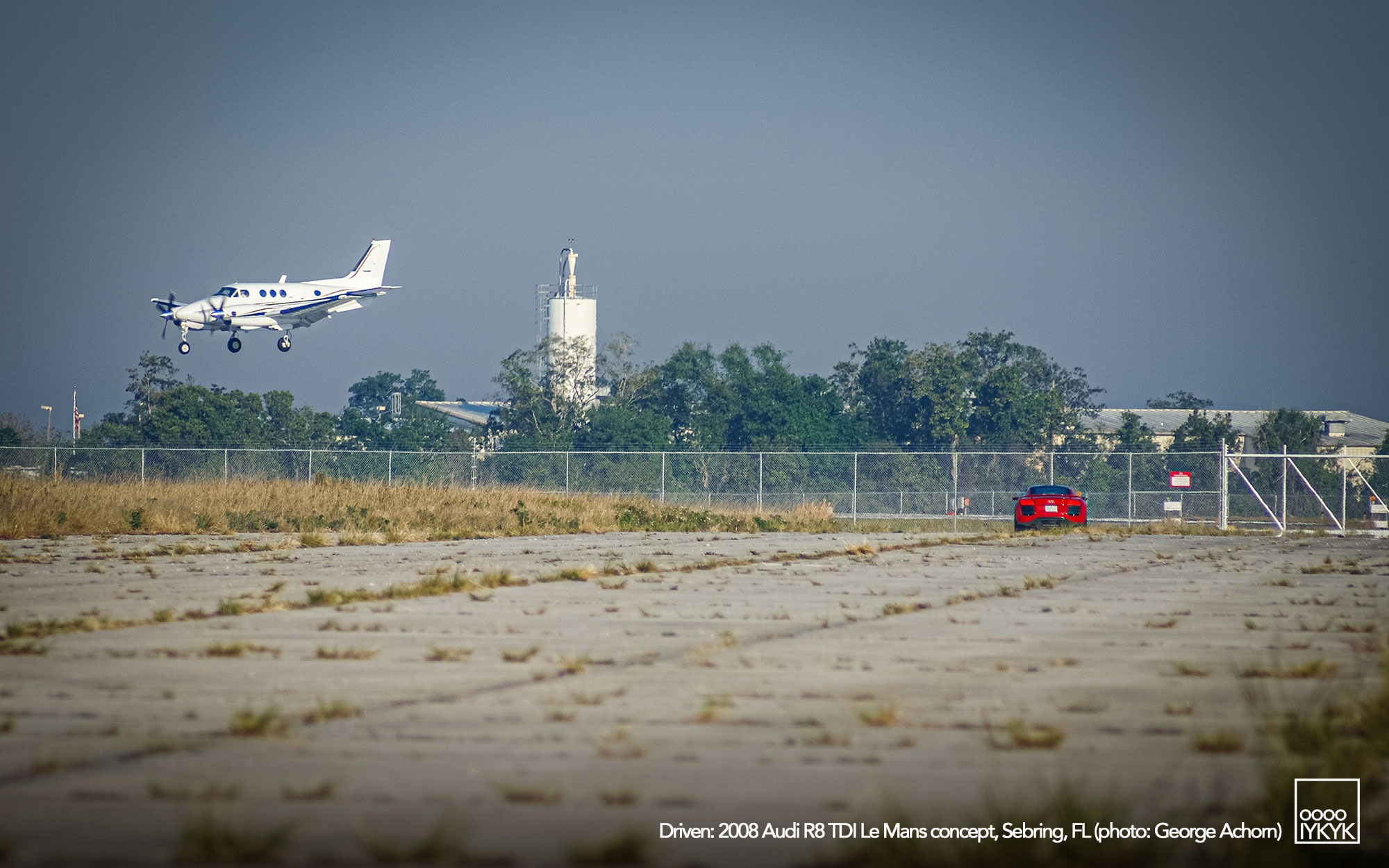
Down at the end of the airfield, I swung the R8 around to head back and bring the car to a stop. Now it’s time to launch it in earnest.
Maybe it’s my knowledge of the cost of this car, or my empathy for the job security of the engineer riding with me, possibly the well-being of the A4-derived gearbox. But I decide to abandon any idea of sidestepping the clutch and churning up a rooster tail of B1-era tarmac. It’s just as well, as even a hard, controlled launch in first brings you to redline in a ridiculously short amount of time.
Snikt. On to second. Power hits you like a brick wall, red stone and mortar smacking you upside the nostrils the whole way down the line. It’s that linear, making the stock R8’s 4.2-liter V8 feel like small displacement. Astonishingly enough, the eight was almost Honda-like in comparison, with the need to keep the revs high – not so with the V12.

Power delivery was something akin to what I’d felt in those years from the big W-12 twin turbo fitted in the Bentley Continental GT, or perhaps nowadays in an e-tron GT. It simply didn’t feel as fast as the R8 4.2, but the speedo said it was. Delivery was smoothly brutal and that made gauging pace hard to do. The low noise level, save intake suckage, was another factor. It’s there but not snarling like the R8 4.2.
I was on to third and I want to keep on it, but my co-driver (read: minder) started motioning his hand down. Alas, I’d been caught red-handed, but it was what it was.
I’d driven the Audi R8 V12 TDI and even wrung it out a bit. When I ran into Audi Sport team driver Allan McNish at the track later that day, he mentioned he hadn’t been able to do more yet than sit in the car. Alas, while talking to Allan that was my only bragging right. He’d nabbed pole for the 12 Hours and no doubt that was an enviable trump card. Oh yeah, he’d also head a couple Le Mans wins under his belt.
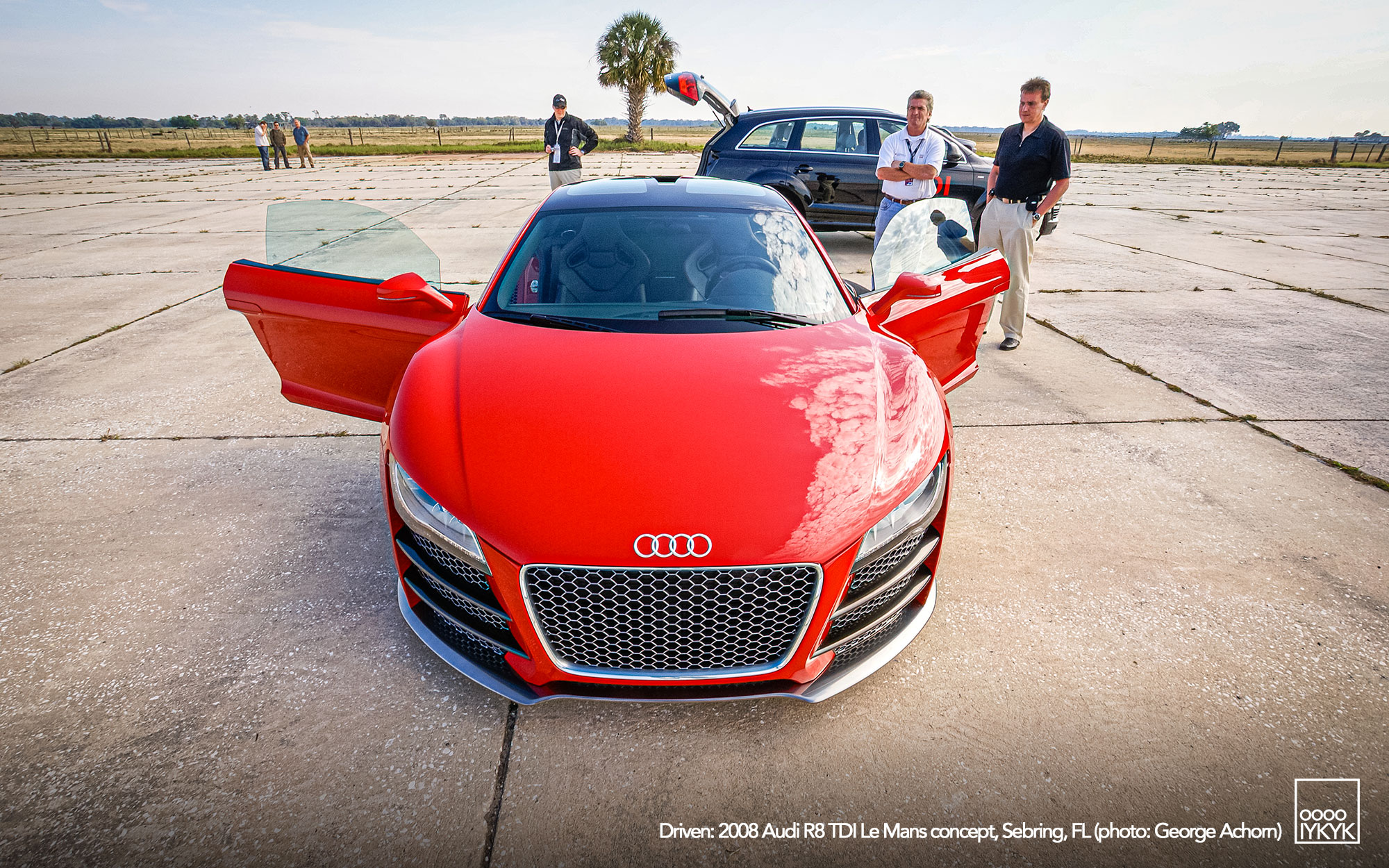
As for the R8 V12 TDI, Audi executives refused back then to be pinned down on actual production of the car. Ultimately, they never got around to building it. Had they done so, they would have had instant credibility given their diesel wins in races like Sebring and Le Mans… at least until years later when the Dieselgate fiasco would turn their diesel technology into more of a liability.
At the time, the then current R8 was sold out for months, with V-10 and open-top variants already in the pipeline. In retrospect, that the production R8 never turned to diesel was likely a blessing. Even after Dieselgate though, it’s hard not to look back at this period romantically. Cars like this and the LMP1s running at places like Sebring and Le Mans certainly suggested a bright future. It does make you wonder how things may have gone differently.
Looking back on it then, having gotten a chance to sample the car was something truly special. Today, it sits in the Audi Tradition collection of retired concept cars. Given what ultimately happened with diesel tech, the chances of it seeing much more than stationary use again is probably unlikely.

